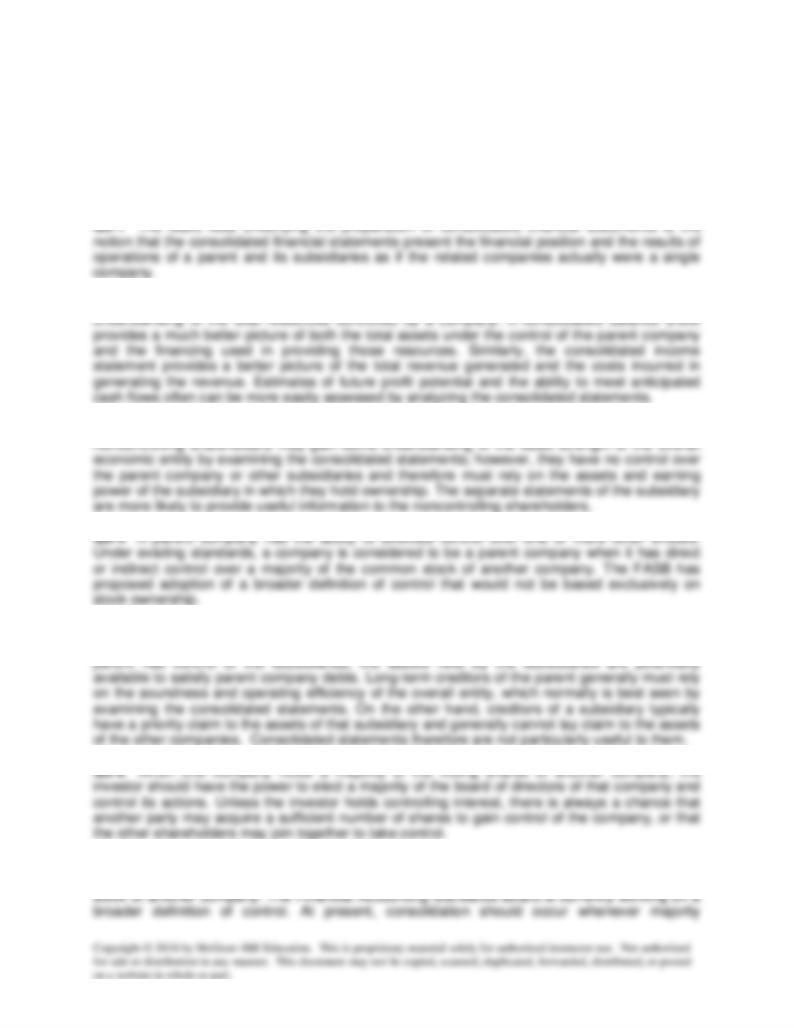
Chapter 03 - The Reporting Entity and Consolidation of Less-Than-Wholly-Owned Subsidiaries with no Differential
CHAPTER 3
THE REPORTING ENTITY AND CONSOLIDATION OF LESS-THAN-WHOLLY-OWNED
SUBSIDIARIES WITH NO DIFFERENTIAL
ANSWERS TO QUESTIONS
Q3-2 Without consolidated statements it is often very difficult for an investor to gain an
Q3-3 Parent company shareholders are likely to find consolidated statements more useful.
Q3-5 Creditors of the parent company have primary claim to the assets held directly by the
parent. Short-term creditors of the parent are likely to look only at those assets. Because the
Q3-7 The primary criterion for consolidation is the ability to directly or indirectly exercise
control. Control normally has been based on ownership of a majority of the voting common
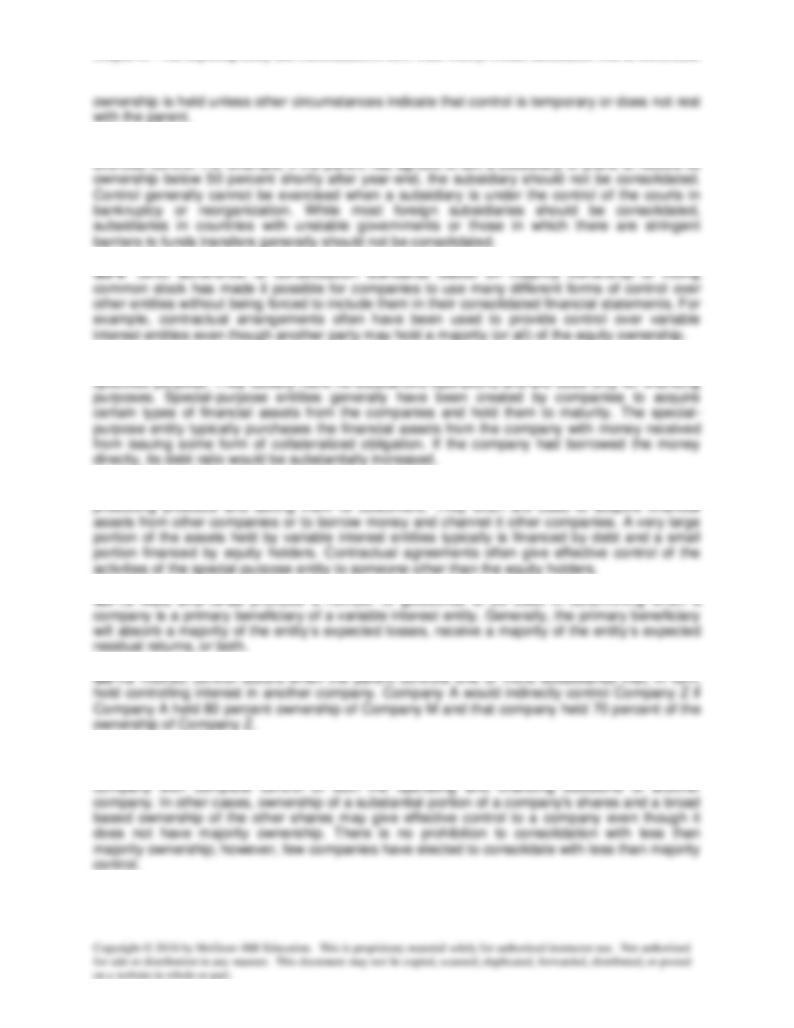
Chapter 03 - The Reporting Entity and Consolidation of Less-Than-Wholly-Owned Subsidiaries with no Differential
Q3-8 Consolidation is not appropriate when control is temporary or when the parent cannot
Q3-10 Special-purpose entities are corporations, trusts, or partnerships created for a single
Q3-11 Variable interest entities normally are not involved in general business activities such as
Q3-14 It is possible for a company to exercise control over another company without holding a
majority of the voting common stock. Contractual agreements, for example, may provide a
Q3-15 Subsidiary shares held by the parent are not owned by an outside party and therefore
cannot be reported as shares outstanding. Those held by the noncontrolling shareholders are
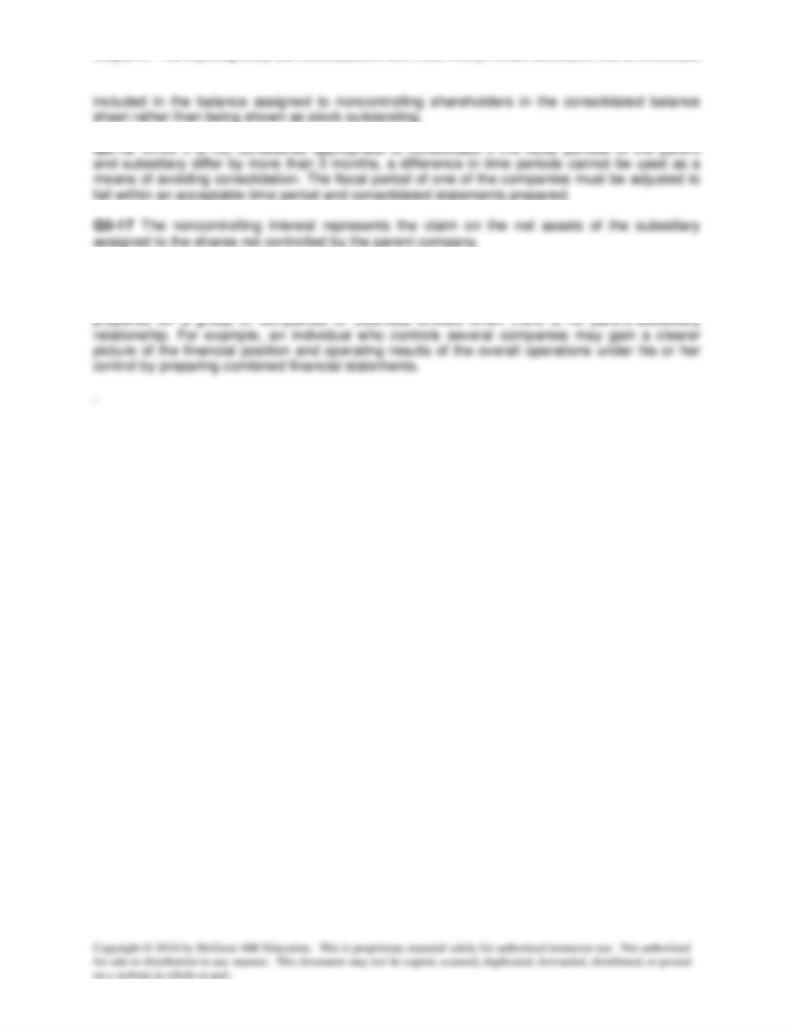
Chapter 03 - The Reporting Entity and Consolidation of Less-Than-Wholly-Owned Subsidiaries with no Differential
Q3-18 The procedures used in preparing consolidated and combined financial statements may
be virtually identical. In general, consolidated statements are prepared when a parent company
either directly or indirectly controls one or more subsidiaries. Combined financial statements are
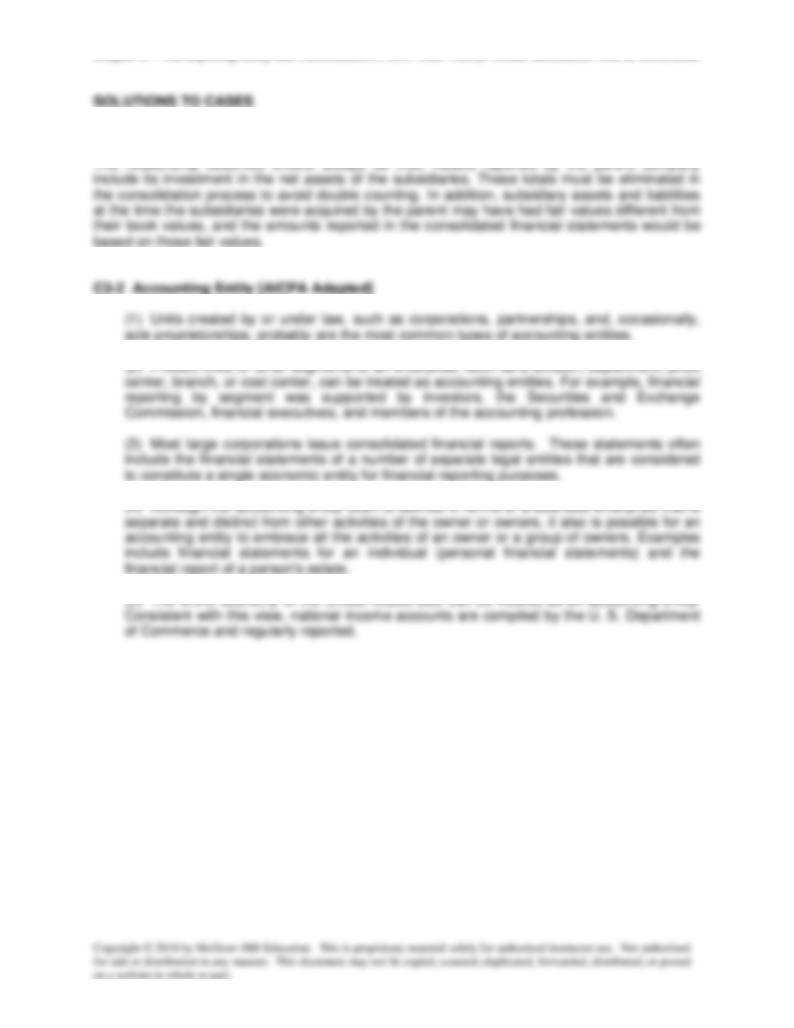
Chapter 03 - The Reporting Entity and Consolidation of Less-Than-Wholly-Owned Subsidiaries with no Differential
C3-1 Computation of Total Asset Values
(2) Product lines or other segments of an enterprise, such as a division, department, profit
(4) Although the accounting entity often is defined in terms of a business enterprise that is
(5) The entire economy of the United States also can be viewed as an accounting entity.
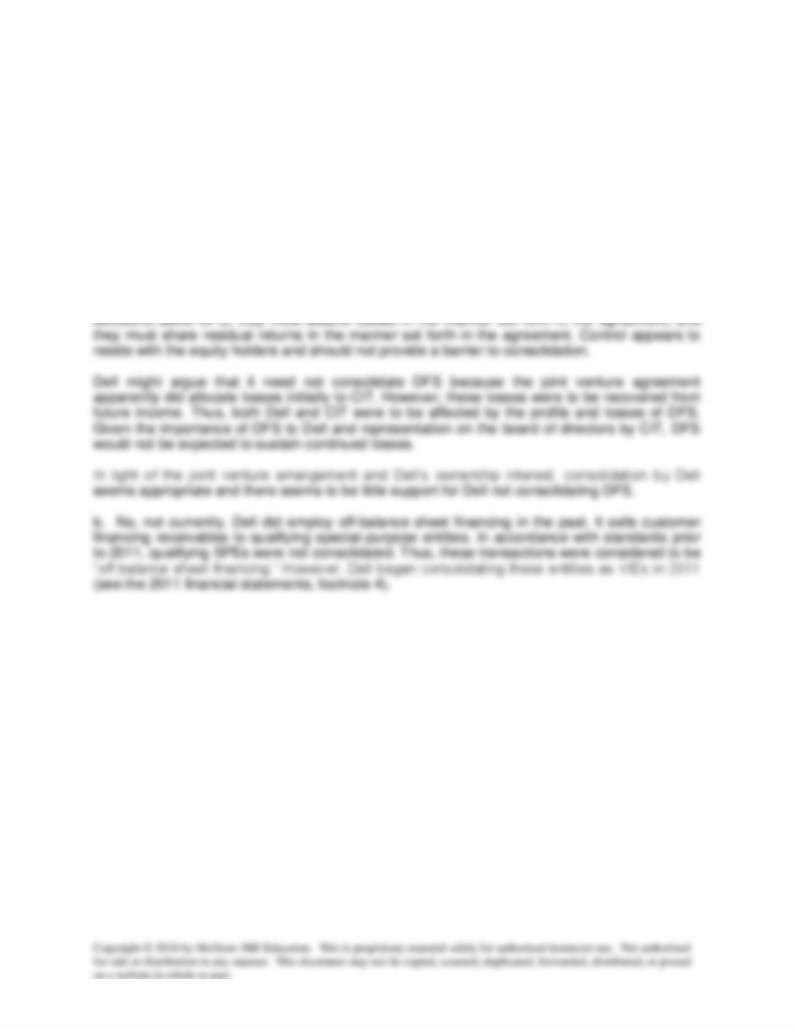
Chapter 03 - The Reporting Entity and Consolidation of Less-Than-Wholly-Owned Subsidiaries with no Differential
C3-3 Joint Venture Investment
a. ASC 810 is the primary authoritative literature dealing with the types of ownership issues
arising in this situation. Under normal circumstances, the company holding majority ownership
in another entity is expected to consolidate that entity in preparing its financial statements. Thus,
unless other circumstances dictate, Dell should have planned to consolidate DFS as a result of
its 70 percent equity ownership. While ASC 810 is highly complex and greater detail of the
ownership agreement may be needed to decide this matter, the literature appears to permit
equity holders to avoid consolidating an entity if the equity holders (1) do not have the ability to
make decisions about the entity’s activities, (2) are not obligated to absorb the expected losses
of the entity if they occur, or (3) do not have the right to receive the expected residual returns of
the entity if they occur [ASC 810-10-15-14].
It does appear that Dell and CIT Group do, in fact, have the ability to make operating and other
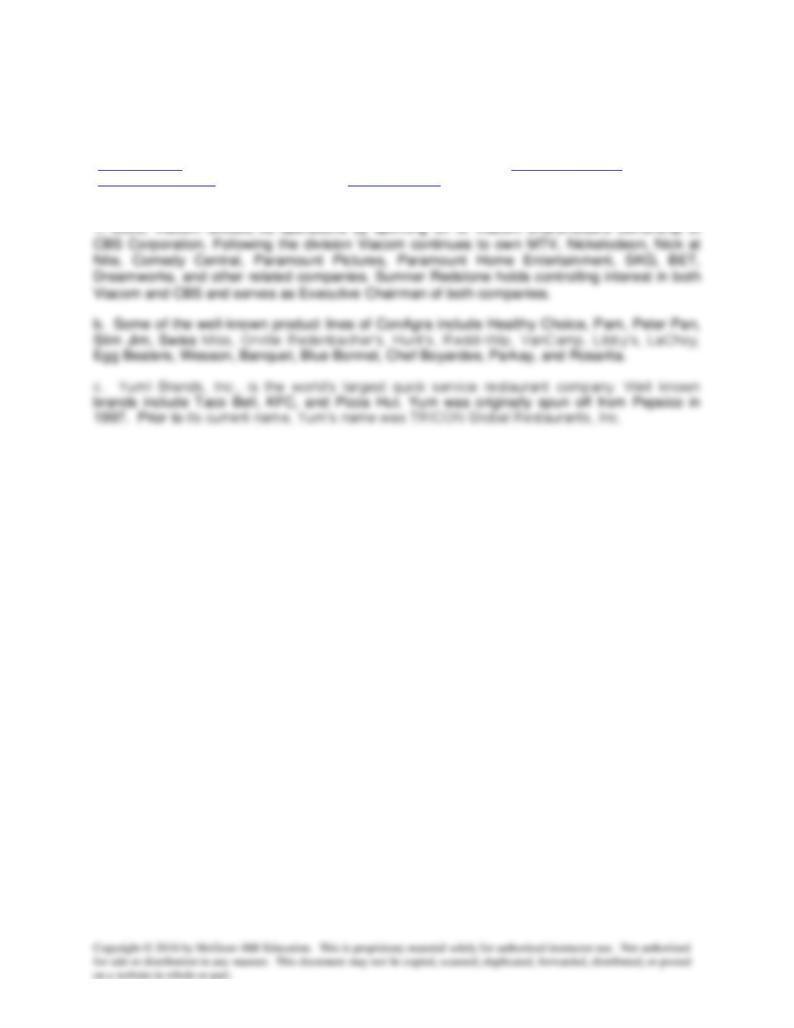
Chapter 03 - The Reporting Entity and Consolidation of Less-Than-Wholly-Owned Subsidiaries with no Differential
C3-4 What Company is That?
Information for answering this case can be obtained from the SEC's EDGAR database
(www.sec.gov) and from the home pages for Viacom (www.viacom.com), ConAgra
(www.conagra.com), and Yum! Brands (www.yum.com).
a.. Viacom is well known for ownership of companies in the entertainment industry. On January
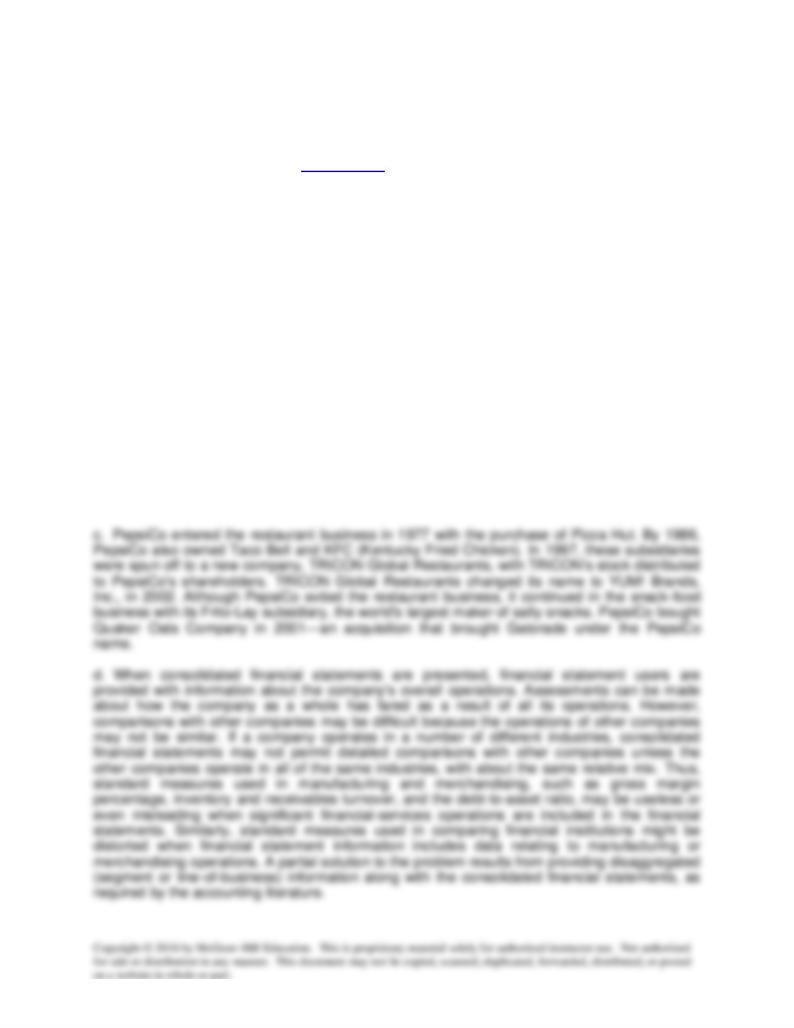
Chapter 03 - The Reporting Entity and Consolidation of Less-Than-Wholly-Owned Subsidiaries with no Differential
C3-5 Subsidiaries and Core Businesses
Most of the information needed to answer this case can be obtained from articles available in
libraries, on the Internet, or through various online databases. Some of the information is
available in filings with the SEC (www.sec.gov).
a. General Electric was never able to turn Kidder, Peabody into a profitable subsidiary. In fact,
Kidder became such a drain on the resources of General Electric, that GE decided to get rid of
Kidder. Unfortunately, GE was unable to sell the company as a whole and ultimately broke the
company into pieces and sold the pieces that it could. GE suffered large losses from its venture
into the brokerage business.
b. Sears, Roebuck and Co. has been a major retailer for many decades. For a while, Sears
attempted to provide virtually all consumer needs so that customers could purchase financial
and related services at Sears in addition to goods. It owned more than 200 other companies.
During that time, Sears sold insurance (Allstate Insurance Group, consisting of many
subsidiaries), real estate (Coldwell Banker Real Estate Group, consisting of many subsidiaries),
brokerage and investment advisor services (Dean Witter), credit cards (Sears and Discover
Card), and various other related services through many different subsidiaries. During the mid-
nineties, Sears sold or spun off most of its subsidiaries that were unrelated to its core business,
including Allstate, Coldwell Banker, Dean Witter, and Discover. On March 24, 2005, Sears
Holding Corporation was established and became the parent company for Sears, Roebuck and
Co. and K Mart Holding Corporation. From an accounting perspective, Kmart acquired Sears,
even though Kmart had just emerged from bankruptcy proceedings. Following the merger the
company now has approximately 2,350 full-line and off-mall stores and 1,100 specialty retail
stores in the United States, and approximately 370 full-line and specialty retail stores in Canada.
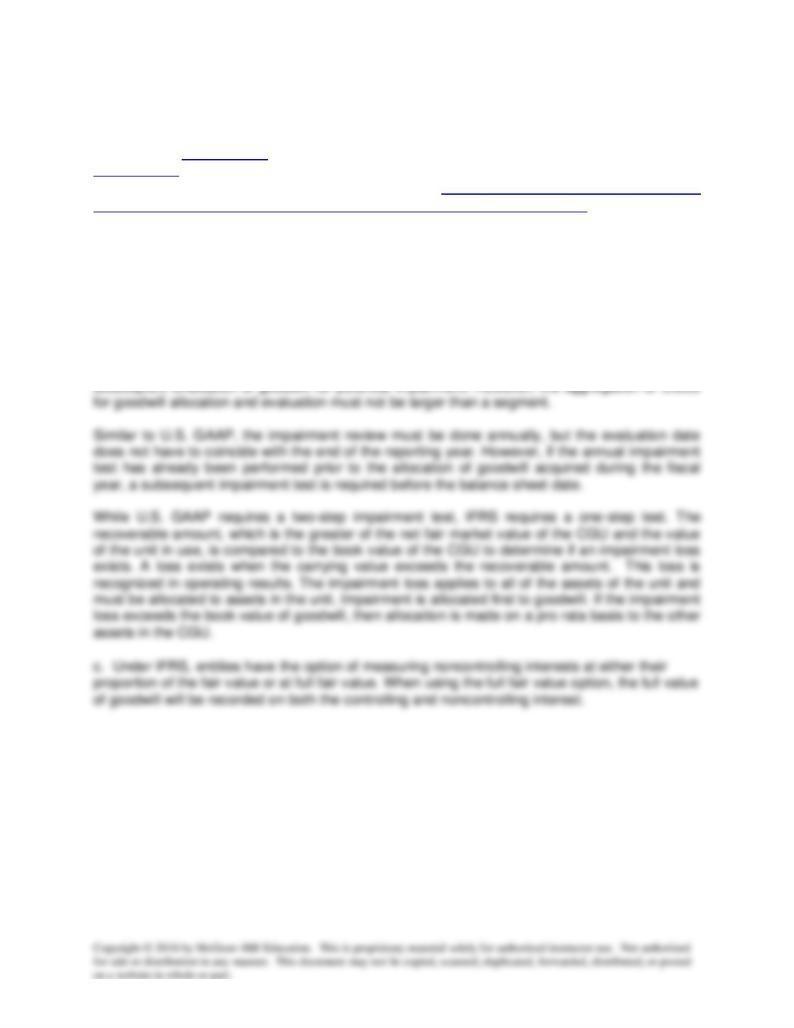
Chapter 03 - The Reporting Entity and Consolidation of Less-Than-Wholly-Owned Subsidiaries with no Differential
C3-6 International Consolidation Issues
The following answers are based on information from the Financial Accounting Standards Board
website at www.fasb.org, the International Accounting Standards Board website at
www.iasb.org, and from the PricewaterhouseCoopers publication entitled IFRS and US GAAP:
similarities and differences, available online at http://www.pwc.com/us/en/issues/ifrs-
reporting/publications/ifrs-and-us-gaap-similarities-and-differences.jhtml.
a. Consolidation under IFRS is required when an entity is able to govern the policies of another
entity in order to obtain benefits. To determine if consolidation is necessary, IFRS focuses on
the concept of control. Factors of control, such as voting rights and contractual rights, are given
by international standards. If control is not apparent, a general assessment of the relationship is
required, including an evaluation of the allocation of risks and benefits.
b. Under IFRS, Goodwill is reviewed annually (or more frequently) for impairment. Goodwill is
initially allocated at the organizational level where cash flows can be clearly identified. These
cash generating units (CGUs) may be combined for purposes of allocating goodwill and for the
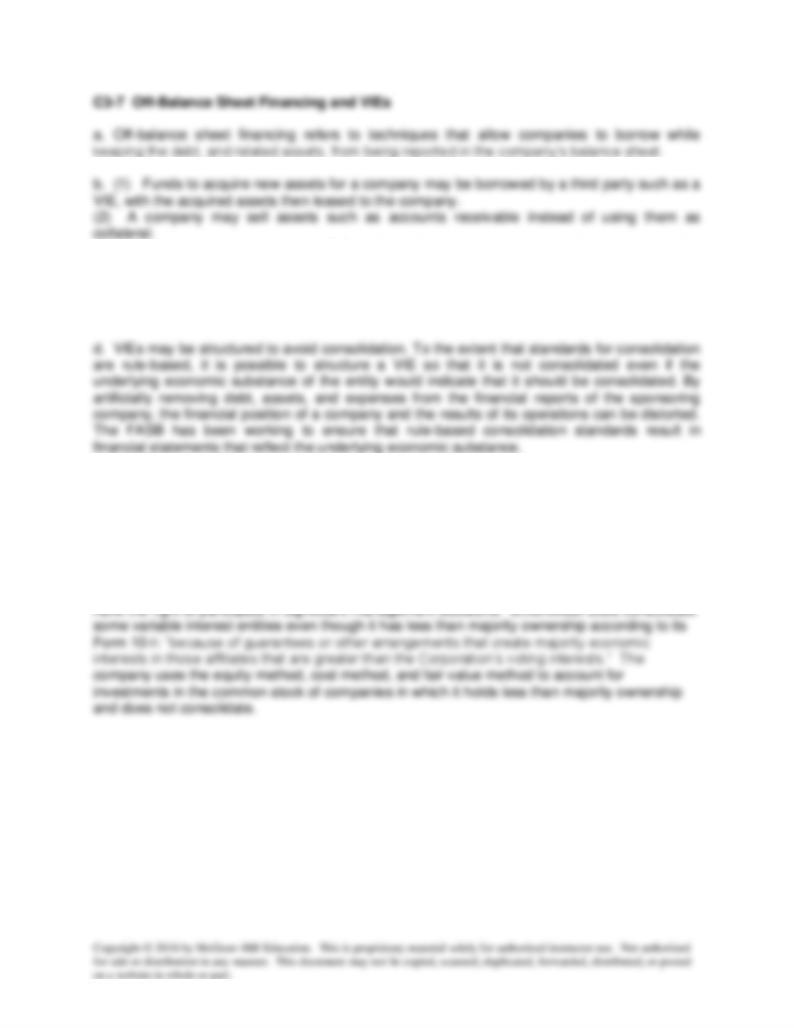
Chapter 03 - The Reporting Entity and Consolidation of Less-Than-Wholly-Owned Subsidiaries with no Differential
(3) A company may create a new VIE and transfer assets to the new entity in exchange for
cash (generally borrowed by the VIE).
c. VIEs may serve a genuine business purpose, such as risk sharing among investors and
isolation of project risk from company risk.
C3-8 Consolidation Differences among Major Corporations
a. Union Pacific is rather unusual for a large company. It has only two subsidiaries:
Union Pacific Railroad Company
Southern Pacific Rail Corporation
b. ExxonMobil does not consolidate majority owned subsidiaries if the minority shareholders
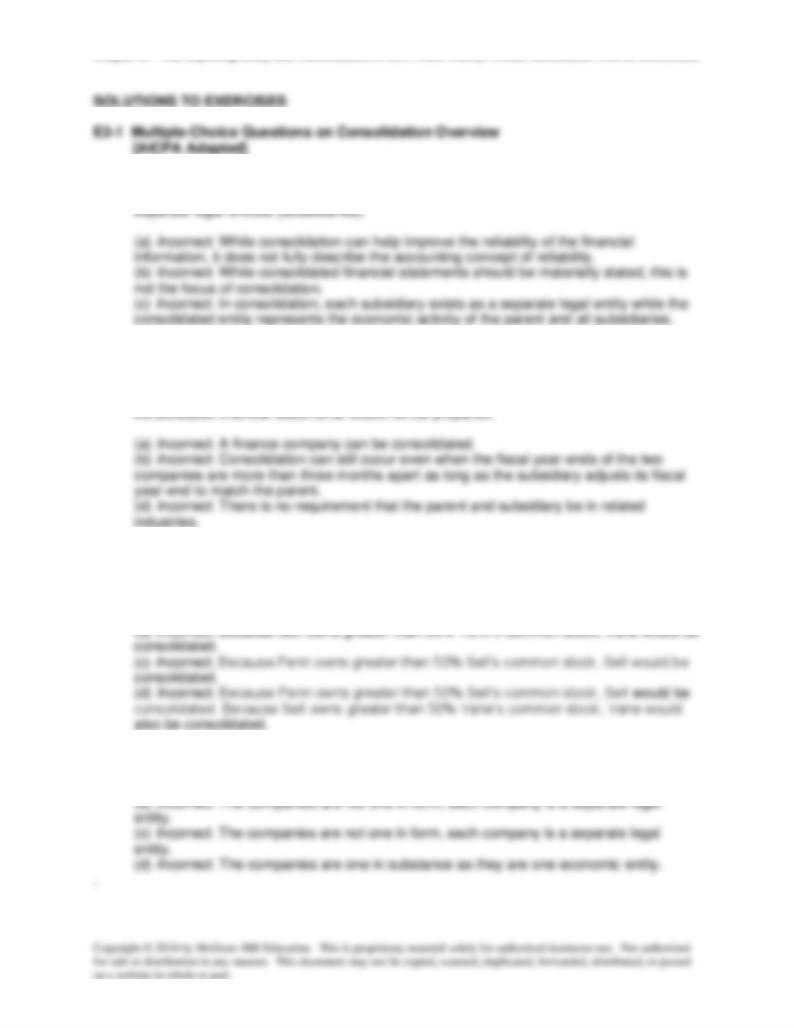
Chapter 03 - The Reporting Entity and Consolidation of Less-Than-Wholly-Owned Subsidiaries with no Differential
1. d – Consolidated financial statements are intended to provide a meaningful representation of
the overall position and activities of a single economic entity comprising a number of
2. c – Under certain circumstances, a company can lose the ability to exercise control of a
subsidiary even when a controlling interest is held. For example, if the subsidiary were
under a legal reorganization or bankruptcy. As long as control cannot be exercised,
3. b – The consolidation method is typically used when ownership is greater than 50% of the
common stock of the subsidiary. Penn directly controls Sell and indirectly controls Vane,
thus, Sell and Vane should both be consolidated.
(a) Incorrect. Because Sell owns greater than 50% Vane’s common stock, Vane would be
4. b – The companies are each separate legal entities, but in substance they are one economic
entity
(a) Incorrect. The companies are not one in form, each company is a separate legal
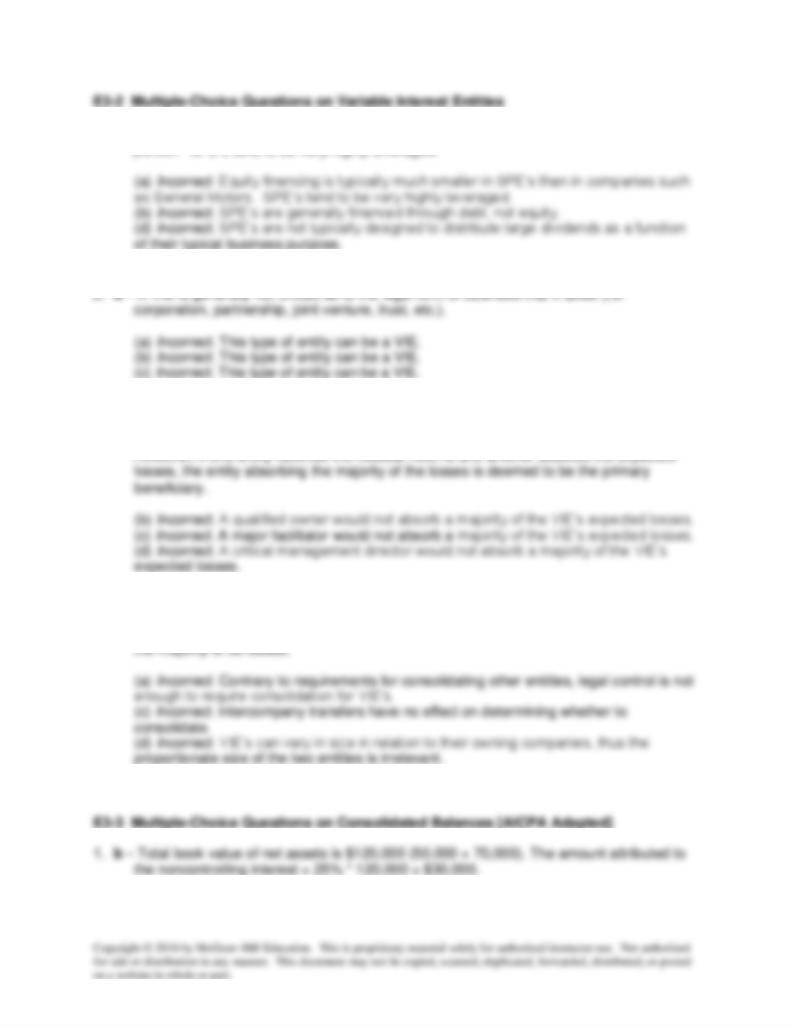
Chapter 03 - The Reporting Entity and Consolidation of Less-Than-Wholly-Owned Subsidiaries with no Differential
1. c – SPE’s are typically financed primarily by debt, while equity financing is only a small
3. a – A primary beneficiary is defined as an enterprise that will absorb the majority of the VIE’s
expected losses, receive a majority of the VIE’s expected residual returns, or both.
4. b – The company that has the most at stake is typically required to consolidate the VIE. This
has been defined as the entity receiving a majority of the VIE’s profits, and/or absorbing
2. b – The consolidated balance in common stock is always equal to the parent’s common
stock and the common stock of the subsidiary is eliminated.
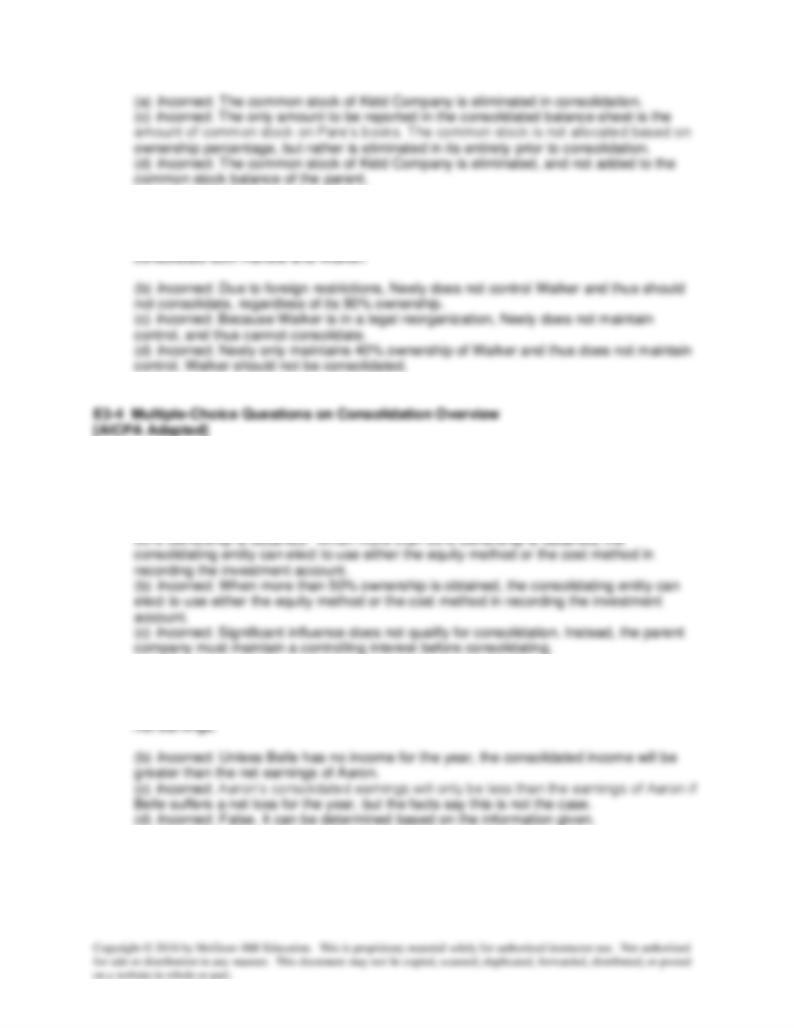
Chapter 03 - The Reporting Entity and Consolidation of Less-Than-Wholly-Owned Subsidiaries with no Differential
3. a – Neely directly controls Randle, and indirectly controls Walker as a result of owning 40%
plus an additional 30% as a result of Randle’s ownership of Walker, thus Neely should
1. d – Consolidation occurs when one company acquires a controlling interest in another
company. This controlling interest is typically defined has owning greater than 50% of the
company.
(a) Incorrect. The equity method alone does not require consolidation until greater than
2. a – The consolidated net earnings contains the net earnings of Aaron as well as the net
earnings of Belle. Thus, the consolidated net earnings are greater than just Aaron’s own
3. b – When the acquisition takes place, X Company only includes the earnings of Y Company
for the portion of the year in which a controlling ownership was held.
(a) Incorrect. Earnings of X Company for the entire year would be included in
consolidated net income.
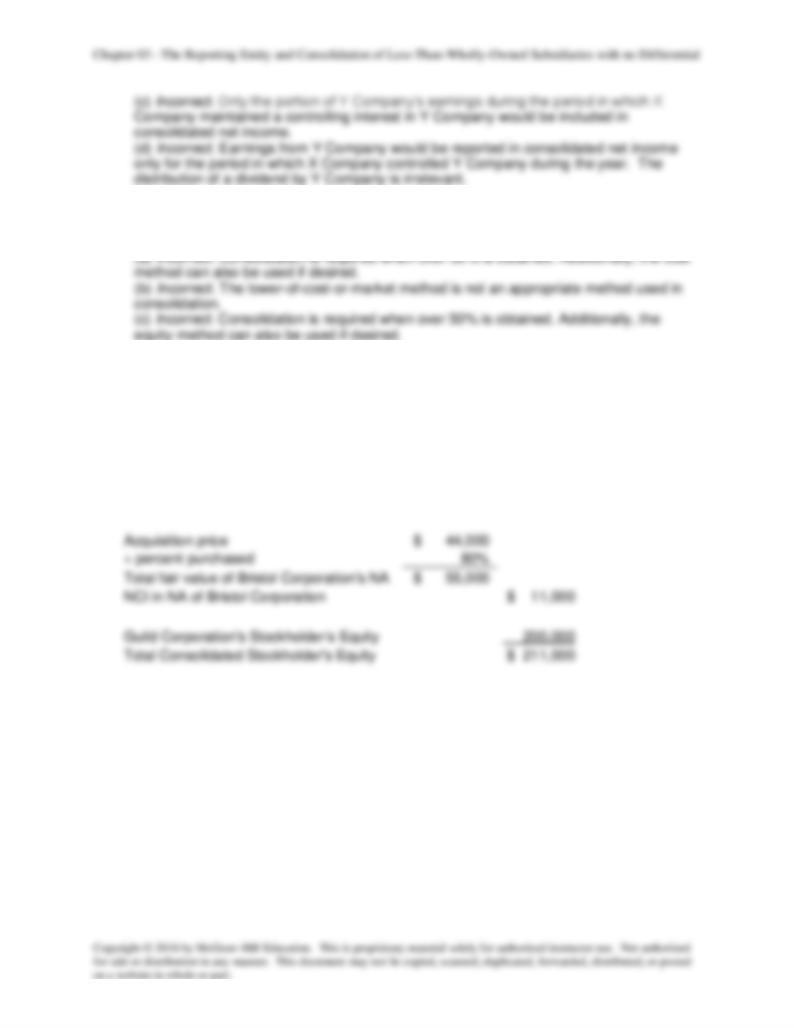
4. d – Consolidation typically occurs when greater than 50% of the voting stock is obtained
because the parent company is said to have control over the subsidiary.
(a) Incorrect. Consolidation is required when over 50% is obtained. Additionally, the cost
E3-5 Balance Sheet Consolidation
a. $470,000 = $470,000 - $44,000 (cash outlay) + $44,000 (investment)
b. $616,000 = ($470,000 - $44,000 (investment) + $190,000
c. $405,000 = $270,000 + $135,000
d. $211,000
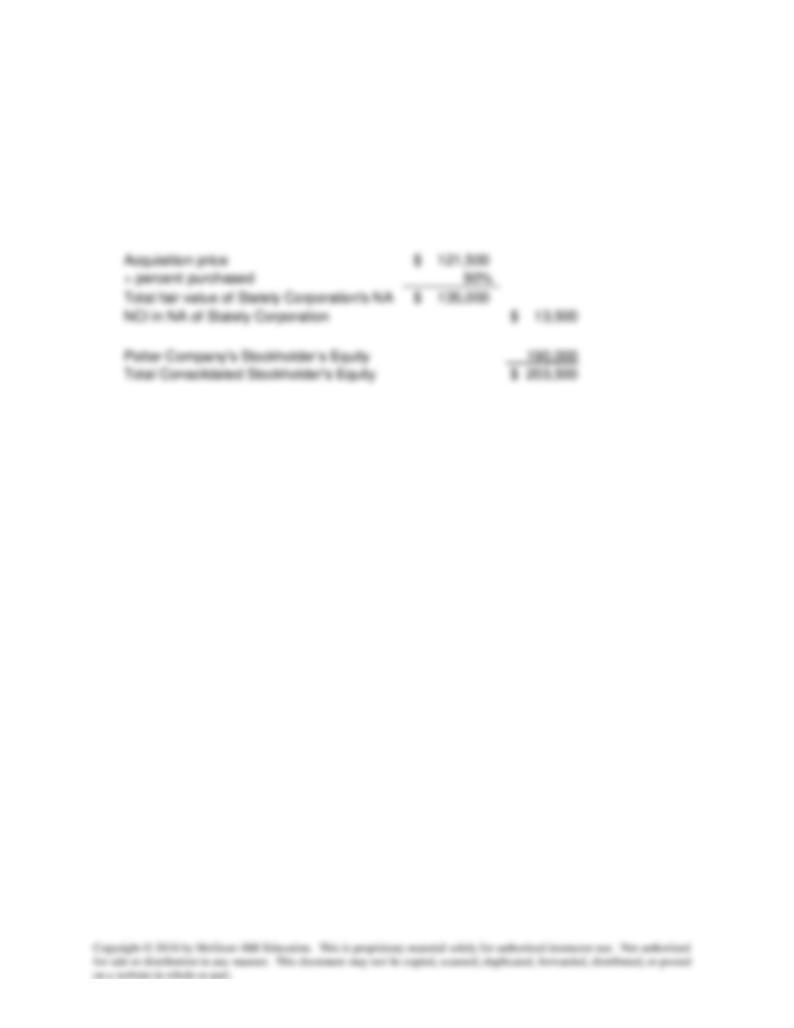
Chapter 03 - The Reporting Entity and Consolidation of Less-Than-Wholly-Owned Subsidiaries with no Differential
E3-6 Balance Sheet Consolidation with Intercompany Transfer
a. $631,500 = $510,000 + $121,500 (investment)
b. $860,000 = $510,000 + $350,000
c. $656,500 = ($320,000 + $121,500) + $215,000
d. $203,500
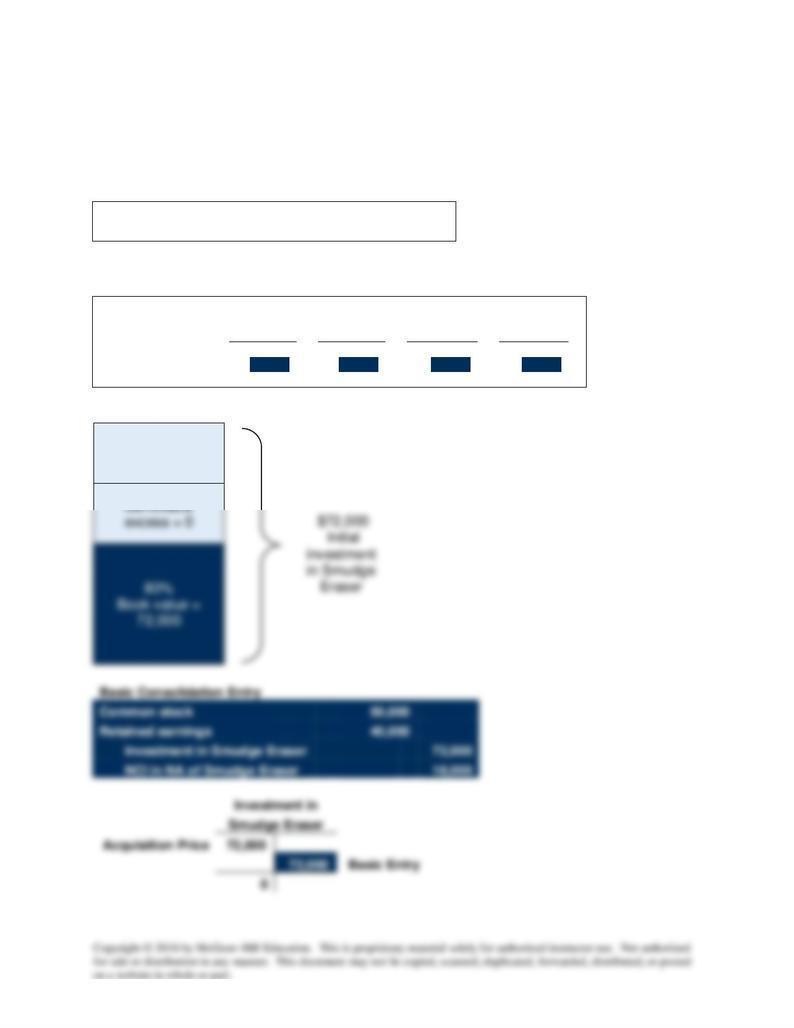
Chapter 03 - The Reporting Entity and Consolidation of Less-Than-Wholly-Owned Subsidiaries with no Differential
E3-7 Subsidiary Acquired for Cash
Note: Since the financial statements of these two companies are quite simple, it is possible to
prepare the consolidated balance sheet without completing all of the steps for a consolidation.
However, we present the formal calculations without skipping any steps.
Equity Method Entries on Fineline Pencil's Books:
Investment in Smudge Eraser
72,000
Cash
72,000
Record the initial investment in Smudge Eraser
Book Value Calculations:
NCI
20%
+
Fineline
Pencil
80%
=
Common
Stock
+
Retained
Earnings
Book value at
acquisition
18,000
72,000
50,000
40,000
1/1/X3
Goodwill = 0
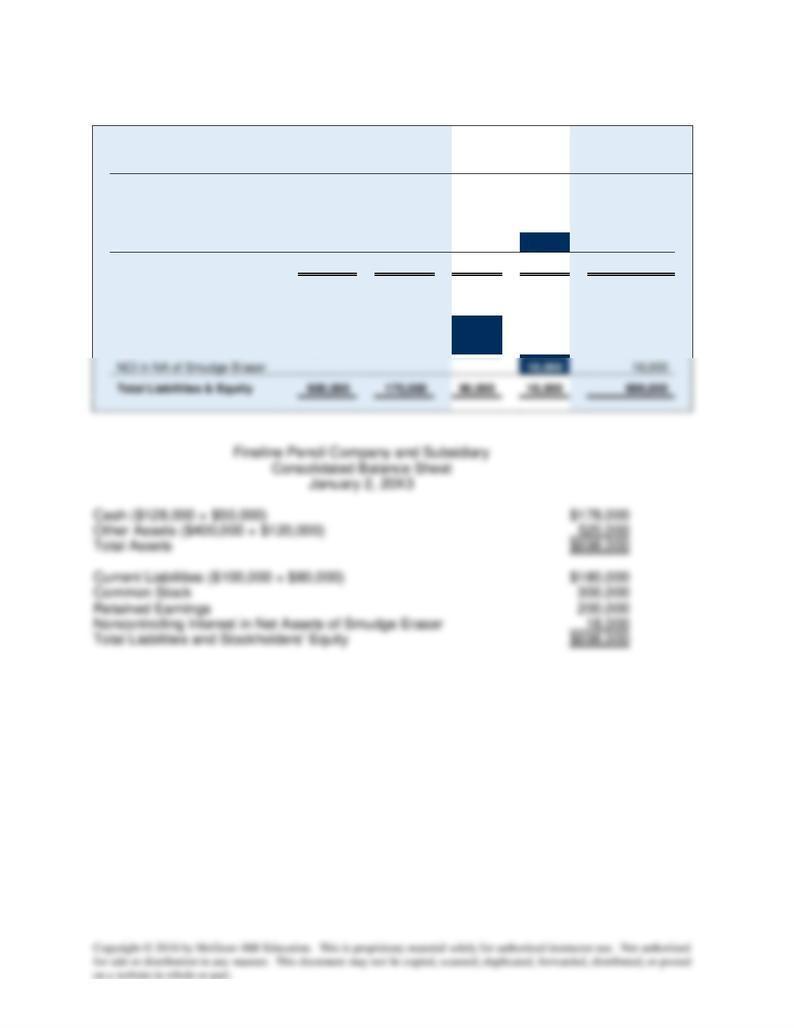
Chapter 03 - The Reporting Entity and Consolidation of Less-Than-Wholly-Owned Subsidiaries with no Differential
E3-7 (continued)
Fineline
Pencil
Smudge
Eraser
Consolidation
Entries
DR
CR
Consolidated
Balance Sheet
Cash
128,000
50,000
178,000
Other Assets
400,000
120,000
520,000
Investment in Smudge Eraser
72,000
72,000
0
Total Assets
600,000
170,000
0
72,000
698,000
Current Liabilities
100,000
80,000
180,000
Common Stock
300,000
50,000
50,000
300,000
Retained Earnings
200,000
40,000
40,000
200,000
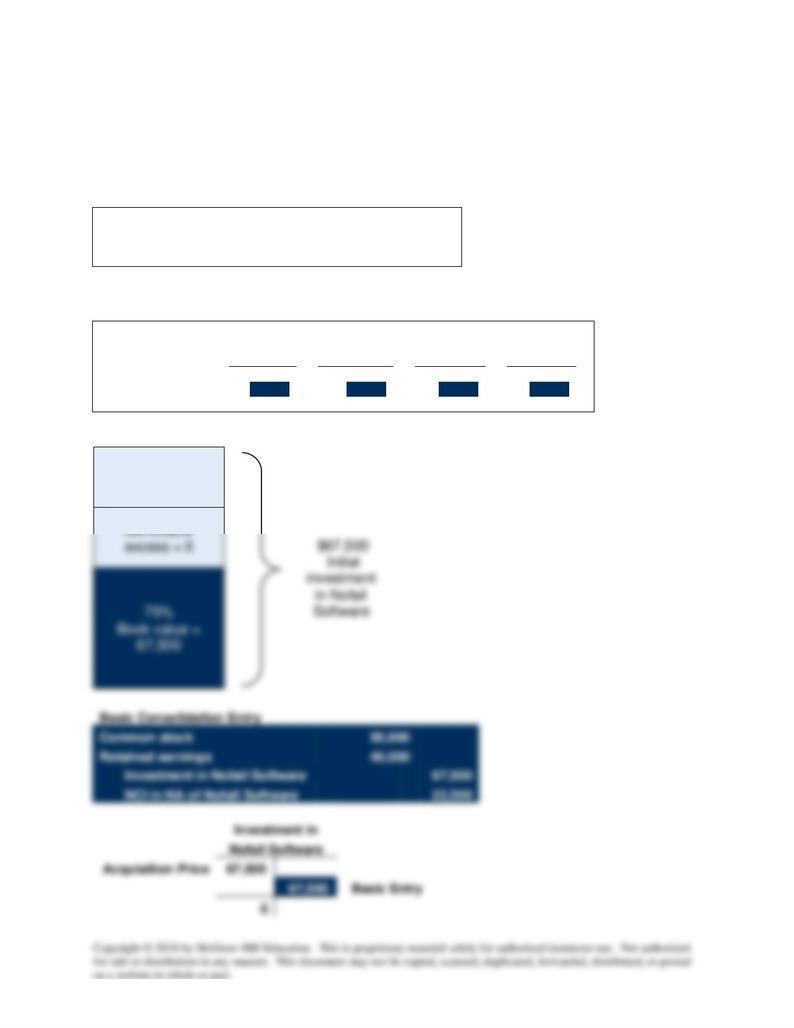
Chapter 03 - The Reporting Entity and Consolidation of Less-Than-Wholly-Owned Subsidiaries with no Differential
E3-8 Subsidiary Acquired with Bonds
Note: Since the financial statements of these two companies are quite simple, it is possible to
prepare the consolidated balance sheet without completing all of the steps for a consolidation.
However, we present the formal calculations without skipping any steps.
Equity Method Entries on Byte Computer's Books:
Investment in Nofail Software
67,500
Bonds Payable
50,000
Premium on Bonds Pay
17,500
Record the initial investment in Nofail Software
Book Value Calculations:
NCI
25%
+
Byte
Computer
75%
=
Common
Stock
+
Retained
Earnings
Book value at
acquisition
22,500
67,500
50,000
40,000
1/1/X3
Goodwill = 0
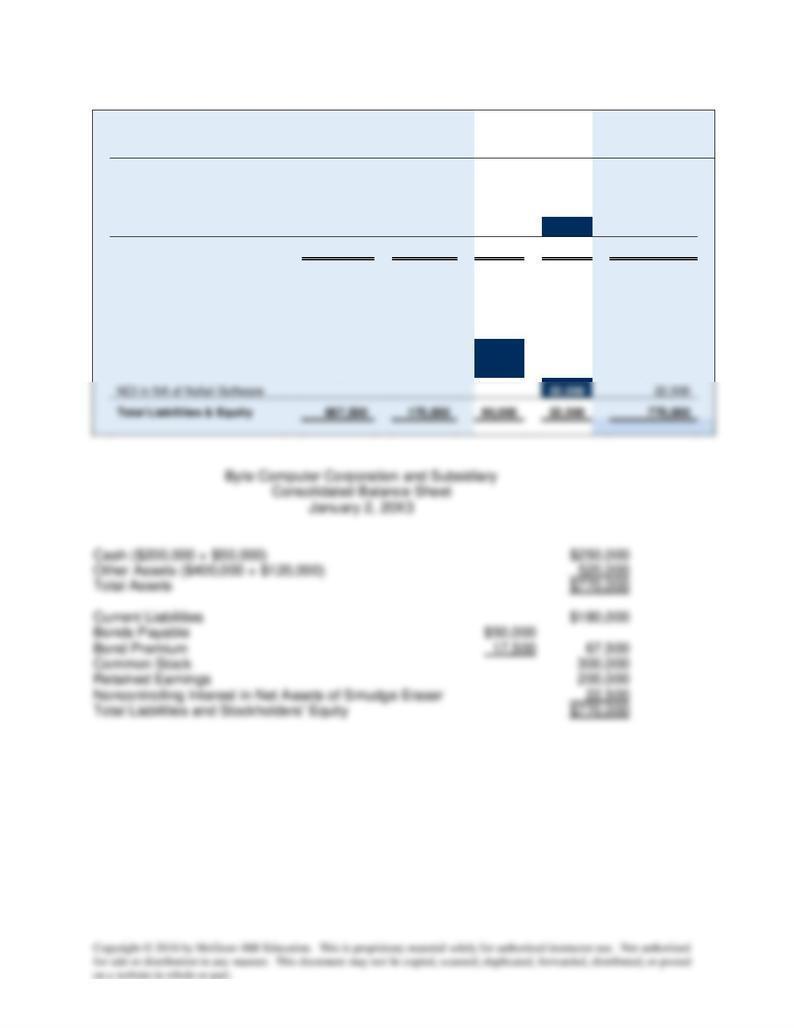
Chapter 03 - The Reporting Entity and Consolidation of Less-Than-Wholly-Owned Subsidiaries with no Differential
E3-8 (continued)
Byte
Computer
Nofail
Software
Consolidation
Entries
DR
CR
Consolidated
Balance Sheet
Cash
200,000
50,000
250,000
Other Assets
400,000
120,000
520,000
Investment in Nofail Software
67,500
67,500
0
Total Assets
667,500
170,000
0
67,500
770,000
Current Liabilities
100,000
80,000
180,000
Bonds Payable
50,000
50,000
Bond Premium
17,500
17,500
Common Stock
300,000
50,000
50,000
300,000
Retained Earnings
200,000
40,000
40,000
200,000

Chapter 03 - The Reporting Entity and Consolidation of Less-Than-Wholly-Owned Subsidiaries with no Differential
E3-9 Subsidiary Acquired by Issuing Preferred Stock
Note: Since the financial statements of these two companies are quite simple, it is possible to
prepare the consolidated balance sheet without completing all of the steps for a consolidation.
However, we present the formal calculations without skipping any steps.
Equity Method Entries on Byte Computer's Books:
Investment in Nofail Software
81,000
Preferred Stock
60,000
Additional Paid-In Capital – Pref. Stock
21,000
Record the initial investment in Nofail Software
Book Value Calculations:
NCI
10%
+
Byte
Computer
90%
=
Common
Stock
+
Retained
Earnings
Book value at
acquisition
9,000
81,000
50,000
40,000
1/1/X3
Goodwill = 0
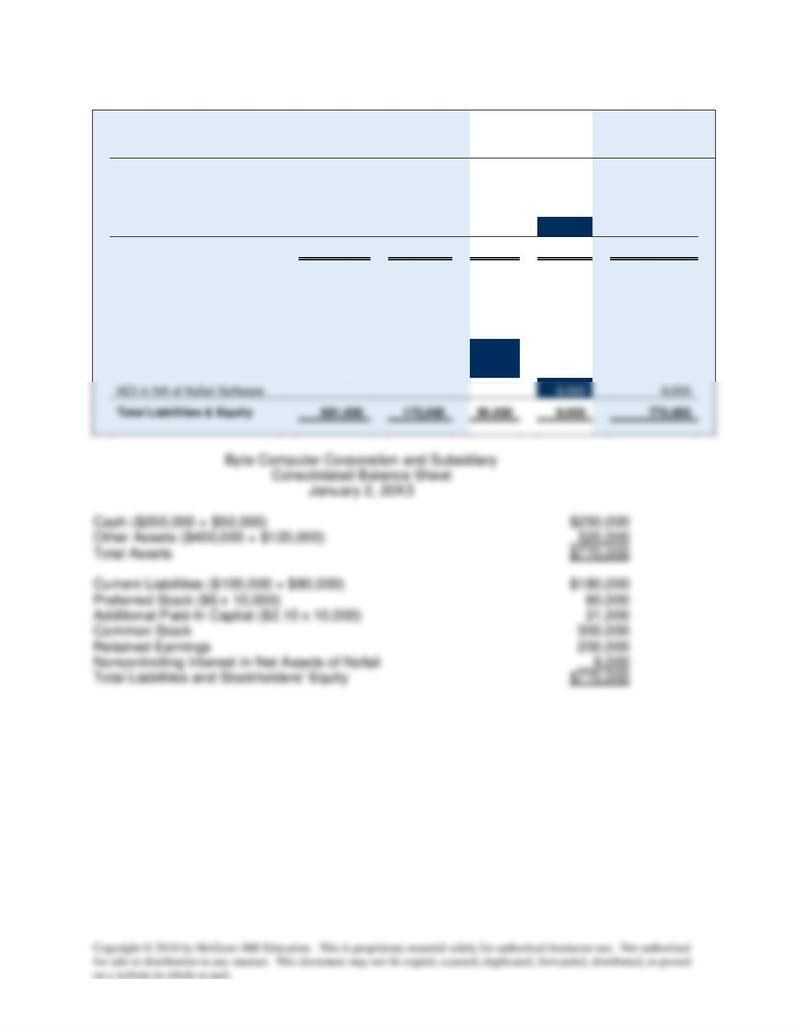
Chapter 03 - The Reporting Entity and Consolidation of Less-Than-Wholly-Owned Subsidiaries with no Differential
E3-9 (continued)
Byte
Computer
Nofail
Software
Consolidation
Entries
DR
CR
Consolidated
Balance Sheet
Cash
200,000
50,000
250,000
Other Assets
400,000
120,000
520,000
Investment in Nofail Software
81,000
81,000
0
Total Assets
681,000
170,000
0
81,000
770,000
Current Liabilities
100,000
80,000
180,000
Preferred Stock
60,000
60,000
Additional Paid-In Capital
21,000
21,000
Common Stock
300,000
50,000
50,000
300,000
Retained Earnings
200,000
40,000
40,000
200,000
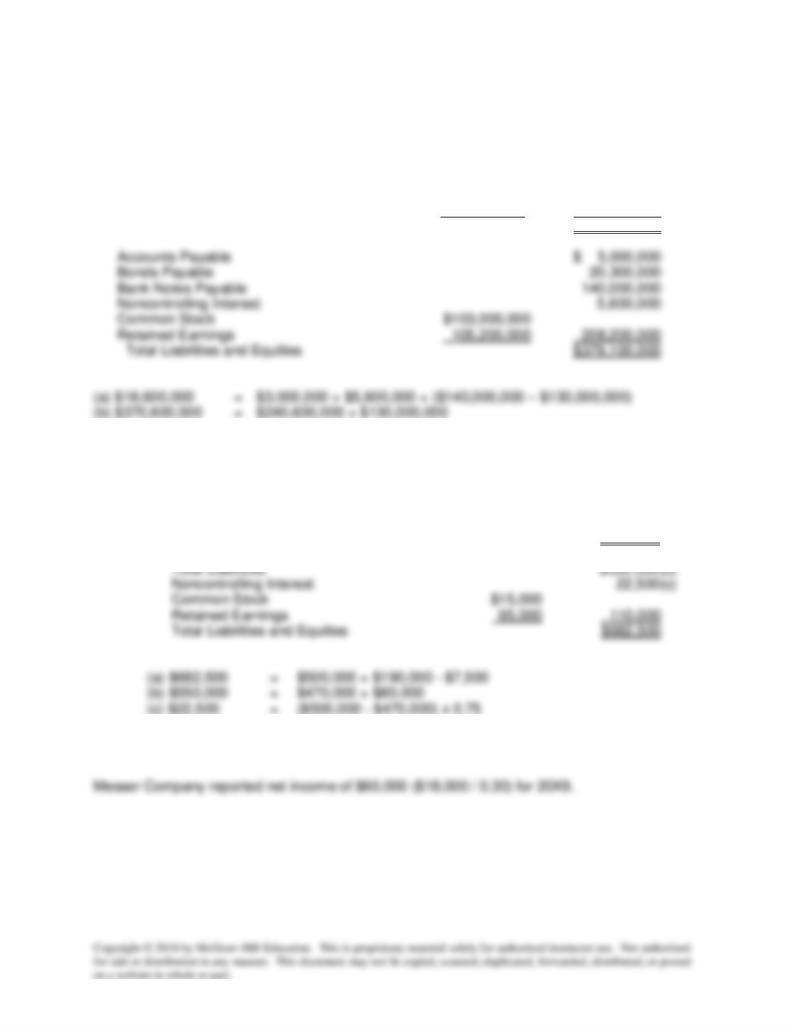
Chapter 03 - The Reporting Entity and Consolidation of Less-Than-Wholly-Owned Subsidiaries with no Differential
E3-10 Reporting for a Variable Interest Entity
Gamble Company
Consolidated Balance Sheet
Cash
$ 18,600,000(a)
Buildings and Equipment
$370,600,000(b)
Less: Accumulated Depreciation
(10,100,000)
360,500,000
Total Assets
$379,100,000
E3-11 Consolidation of a Variable Interest Entity
Teal Corporation
Consolidated Balance Sheet
Total Assets
$682,500(a)
E3-12 Computation of Subsidiary Net Income
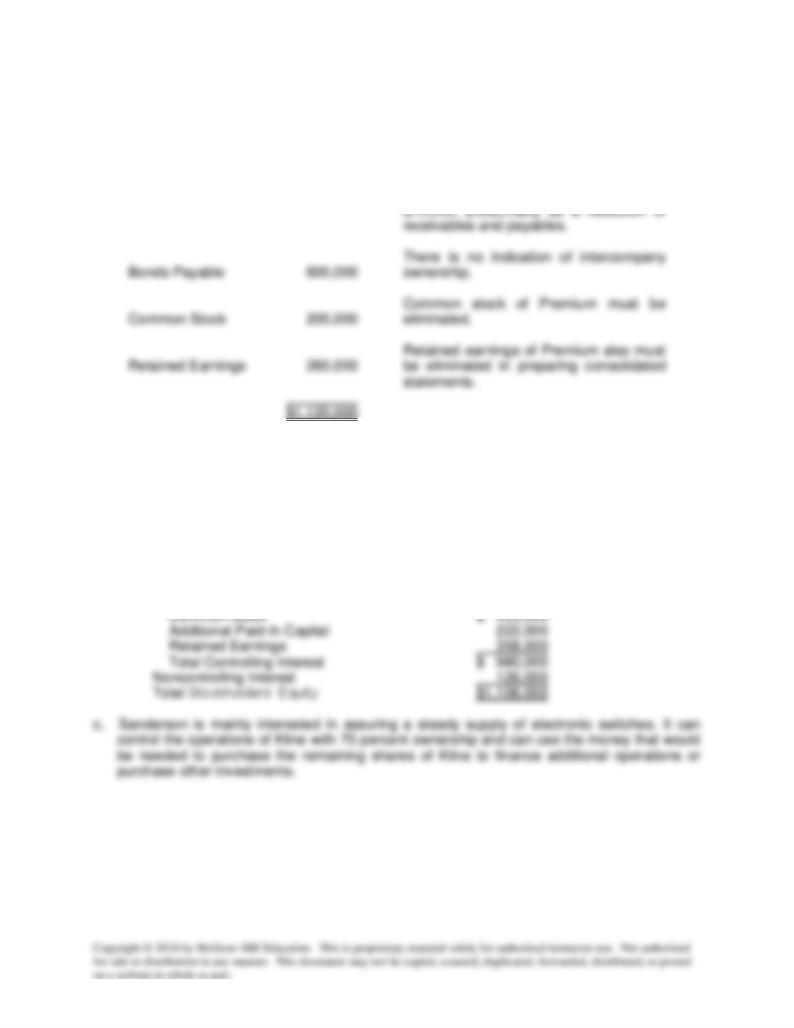
Chapter 03 - The Reporting Entity and Consolidation of Less-Than-Wholly-Owned Subsidiaries with no Differential
E3-13 Incomplete Consolidation
a. Belchfire apparently owns 100 percent of the stock of Premium Body Shop since the
balance in the investment account reported by Belchfire is equal to the net book value of
Premium Body Shop.
b.
Accounts Payable
$ 60,000
Accounts receivable were reduced by
E3-14 Noncontrolling Interest
a. The total noncontrolling interest reported in the consolidated balance sheet at January 1,
20X7, is $126,000 ($420,000 x .30).
b. The stockholders' equity section of the consolidated balance sheet includes the claim of the
noncontrolling interest and the stockholders' equity section of the subsidiary is eliminated
when the consolidated balance sheet is prepared:
Controlling Interest:
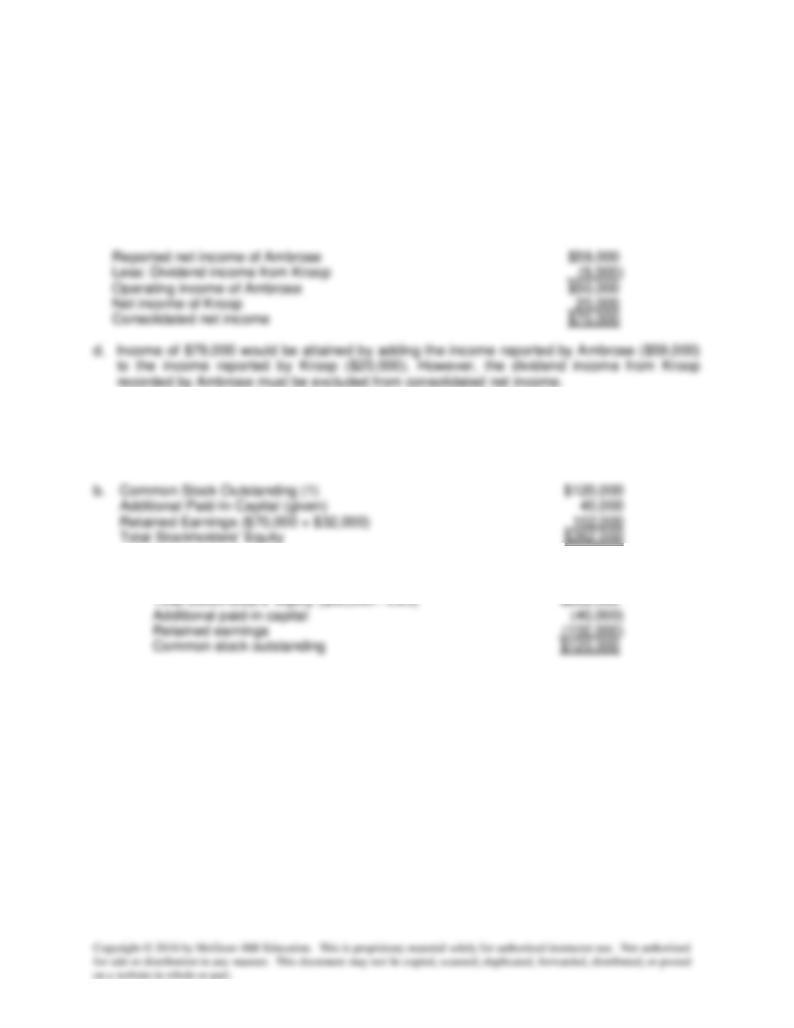
Chapter 03 - The Reporting Entity and Consolidation of Less-Than-Wholly-Owned Subsidiaries with no Differential
E3-15 Computation of Consolidated Net Income
a. Ambrose should report income from its subsidiary of $15,000 ($20,000 x .75) rather than
dividend income of $9,000.
b. A total of $5,000 ($20,000 x 0.25) should be assigned to the noncontrolling interest in the
20X4 consolidated income statement.
c. Consolidated net income of $70,0000 should be reported for 20X4, computed as follows:
E3-16 Computation of Subsidiary Balances
a. Light's net income for 20X2 was $32,000 ($8,000 / 0.25).
(1) Computation of common stock outstanding:
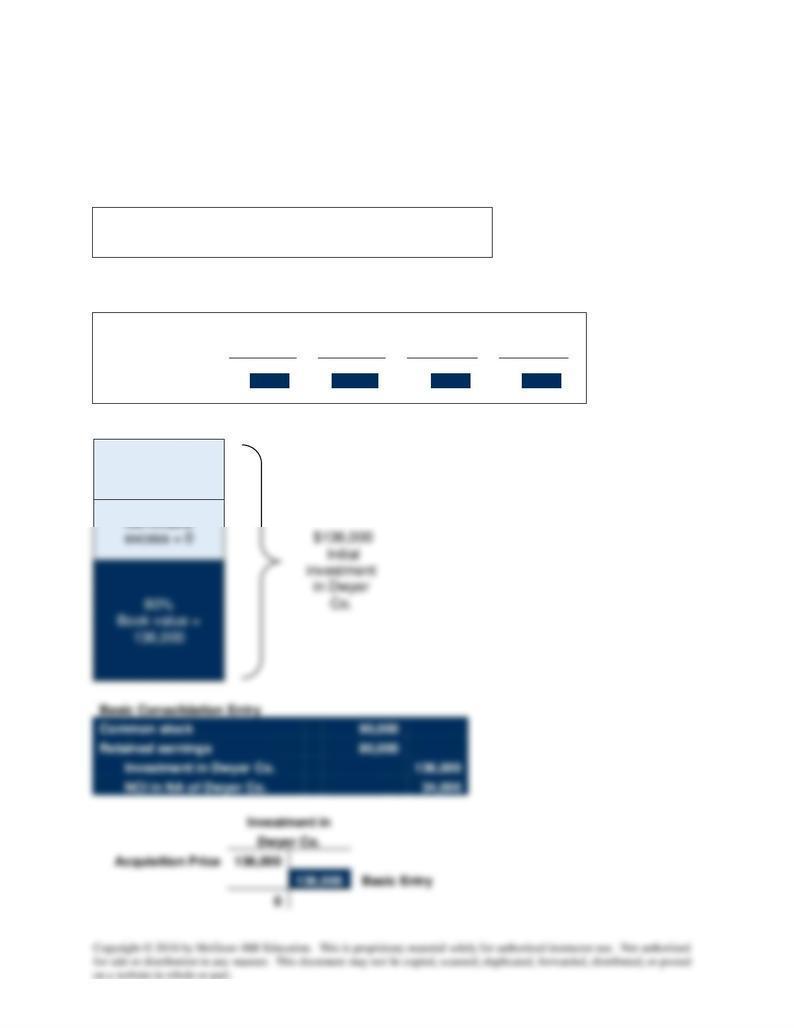
Chapter 03 - The Reporting Entity and Consolidation of Less-Than-Wholly-Owned Subsidiaries with no Differential
E3-17 Subsidiary Acquired at Net Book Value
Note: Since the financial statements of these two companies are quite simple, it is possible to
prepare the consolidated balance sheet without completing all of the steps for a consolidation.
However, we present the formal calculations without skipping any steps.
Equity Method Entries on Banner Corp.'s Books:
Investment in Dwyer Co.
136,000
Cash
136,000
Record the initial investment in Dwyer Co.
Book Value Calculations:
NCI
20%
+
Banner
Corp.
80%
=
Common
Stock
+
Retained
Earnings
Book value at
acquisition
34,000
136,000
90,000
80,000
1/1/X8
Goodwill = 0
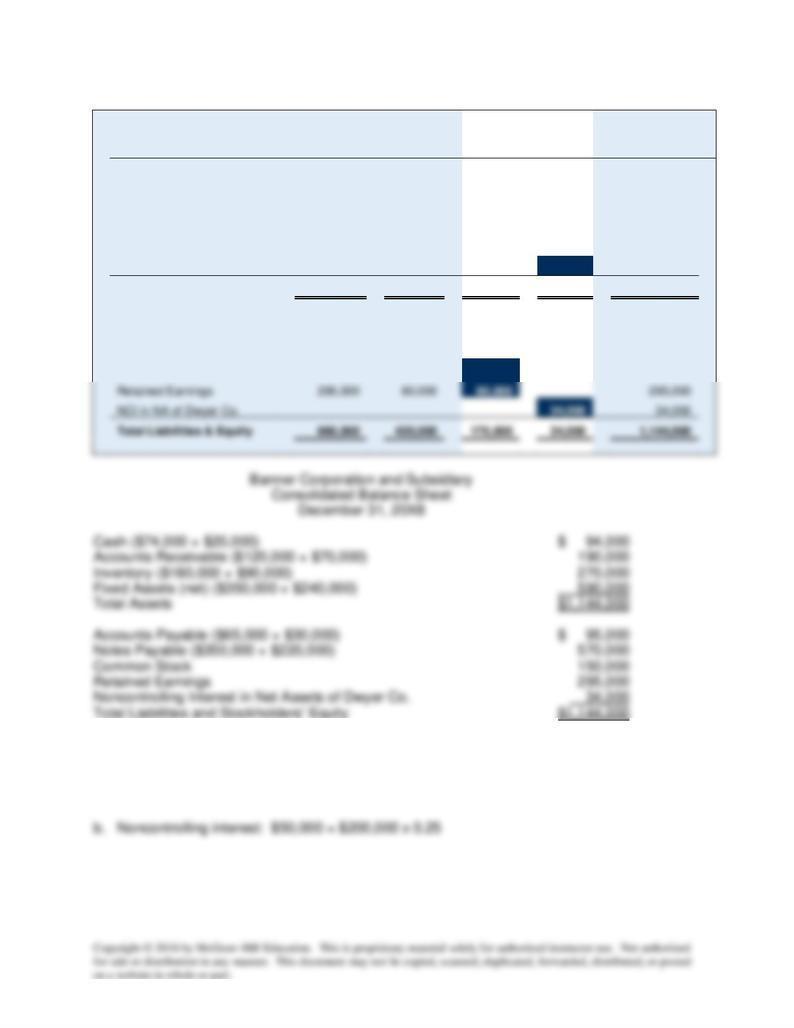
Chapter 03 - The Reporting Entity and Consolidation of Less-Than-Wholly-Owned Subsidiaries with no Differential
E3-17 (continued)
Banner
Corp.
Dwyer
Co.
Consolidation
Entries
DR
CR
Consolidated
Balance Sheet
Cash
74,000
20,000
94,000
Accounts Receivable
120,000
70,000
190,000
Inventory
180,000
90,000
270,000
Fixed Assets (net)
350,000
240,000
590,000
Investment in Dwyer Co.
136,000
136,000
0
Total Assets
860,000
420,000
0
136,000
1,144,000
Accounts Payable
65,000
30,000
95,000
Notes Payable
350,000
220,000
570,000
Common Stock
150,000
90,000
90,000
150,000
E3-18 Acquisition of Majority Ownership
a. Net identifiable assets: $720,000 = $520,000 + $200,000
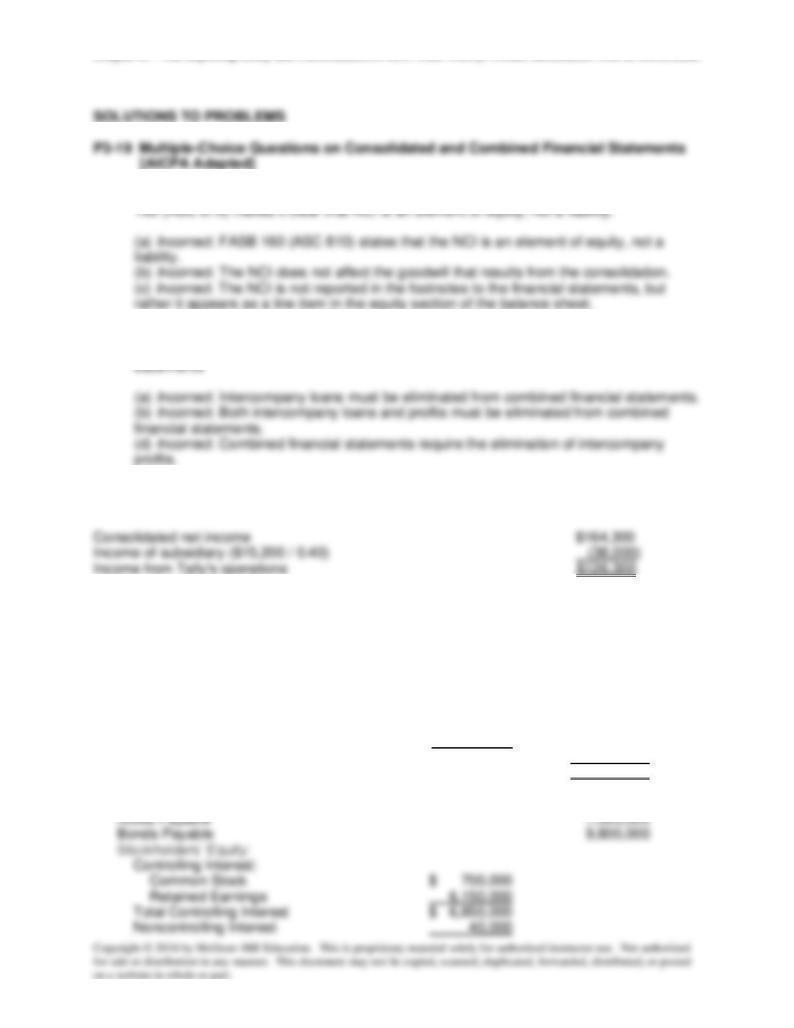
Chapter 03 - The Reporting Entity and Consolidation of Less-Than-Wholly-Owned Subsidiaries with no Differential
1. d – While previously reported in the ‘mezzanine’ area between liabilities and equity, FASB
2. c – Similar to consolidated statements, combined financial statements require the removal of
all intercompany loans and profits. Thus, neither amount is recorded in the combined
P3-20 Determining Net Income of Parent Company
P3-21 Consolidation of a Variable Interest Entity
Stern Corporation
Consolidated Balance Sheet
January 1, 20X4
Cash
$ 8,150,000
(a)
Accounts Receivable
$12,200,000
(b)
Less: Allowance for Uncollectibles
(610,000)
(c)
11,590,000
Other Assets
5,400,000
Total Assets
$25,140,000
Accounts Payable
$ 950,000
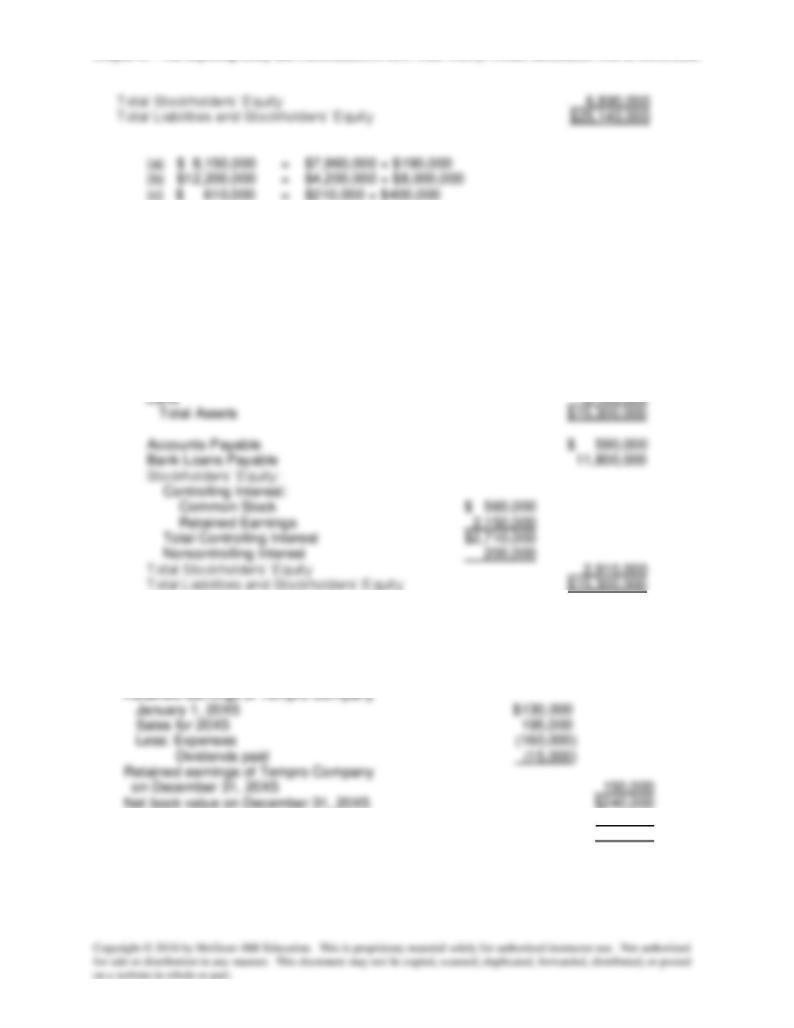
Chapter 03 - The Reporting Entity and Consolidation of Less-Than-Wholly-Owned Subsidiaries with no Differential
P3-22 Reporting for Variable Interest Entities
Purified Oil Company
Consolidated Balance Sheet
Cash
$ 640,000
Drilling Supplies
420,000
Accounts Receivable
640,000
Equipment (net)
8,500,000
P3-23 Parent Company and Consolidated Amounts
a.
Common stock of Tempro Company
on December 31, 20X5
$ 90,000
Proportion of stock acquired by Quoton
x 0.80
Purchase price
$192,000
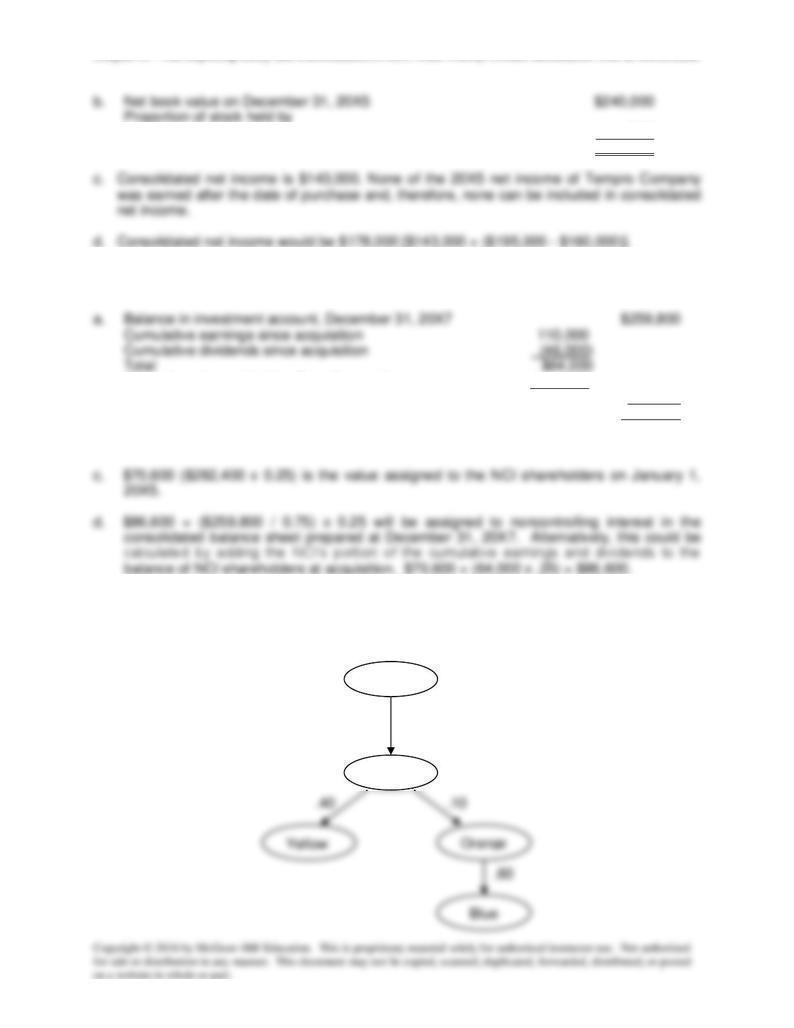
Chapter 03 - The Reporting Entity and Consolidation of Less-Than-Wholly-Owned Subsidiaries with no Differential
noncontrolling interest
x 0.20
Balance assigned to noncontrolling interest
$ 48,000
P3-24 Parent Company and Consolidated Balances
Proportion of stock held by True Corporation
x 0.75
Total Amount Debited to Investment Account
(48,000)
Purchase Amount
$211,800
b. $282,400 ($211,800 / 0.75) is the fair value of net assets on January 1, 20X5
P3-25 Indirect Ownership
The following ownership chain exists:
Purple
.70
Green
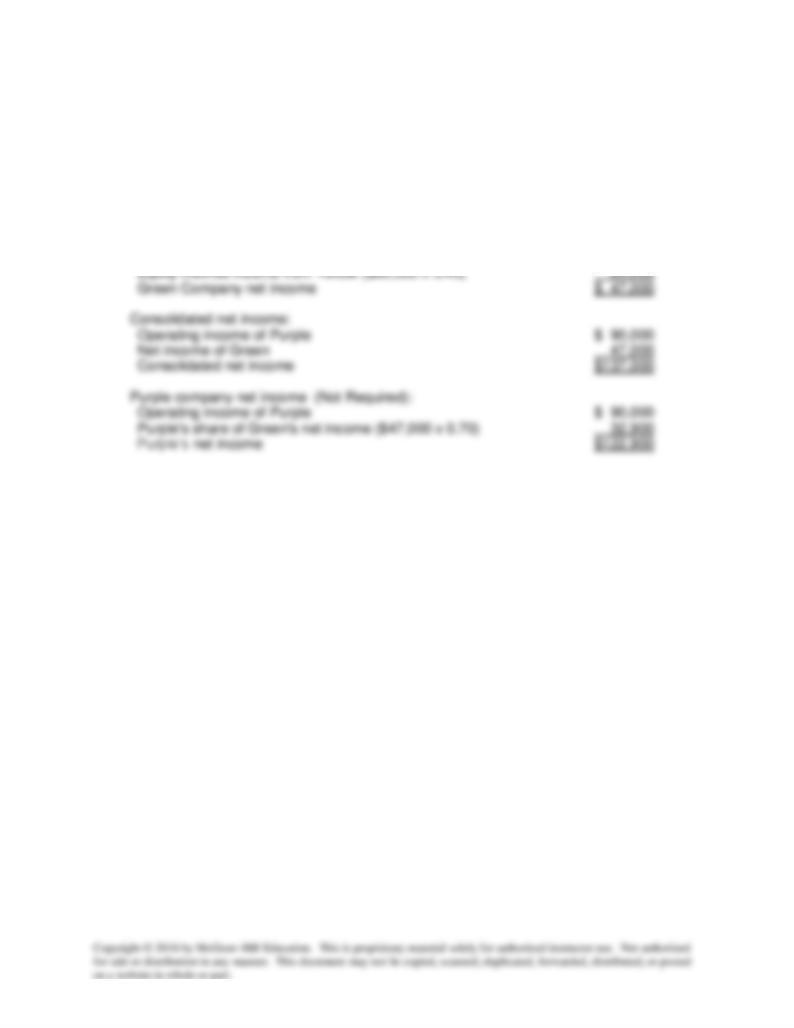
Chapter 03 - The Reporting Entity and Consolidation of Less-Than-Wholly-Owned Subsidiaries with no Differential
P3-25 (continued)
The earnings of Blue Company and Orange Corporation are included under cost method
reporting due to the 10 percent ownership level of Orange Corporation. The earnings of Yellow
Corporation are included under equity method accounting due to the 40 percent ownership
level.
Net income of Green Company:
Reported operating income
$ 20,000
Dividend income from Orange ($30,000 x 0.10)
3,000
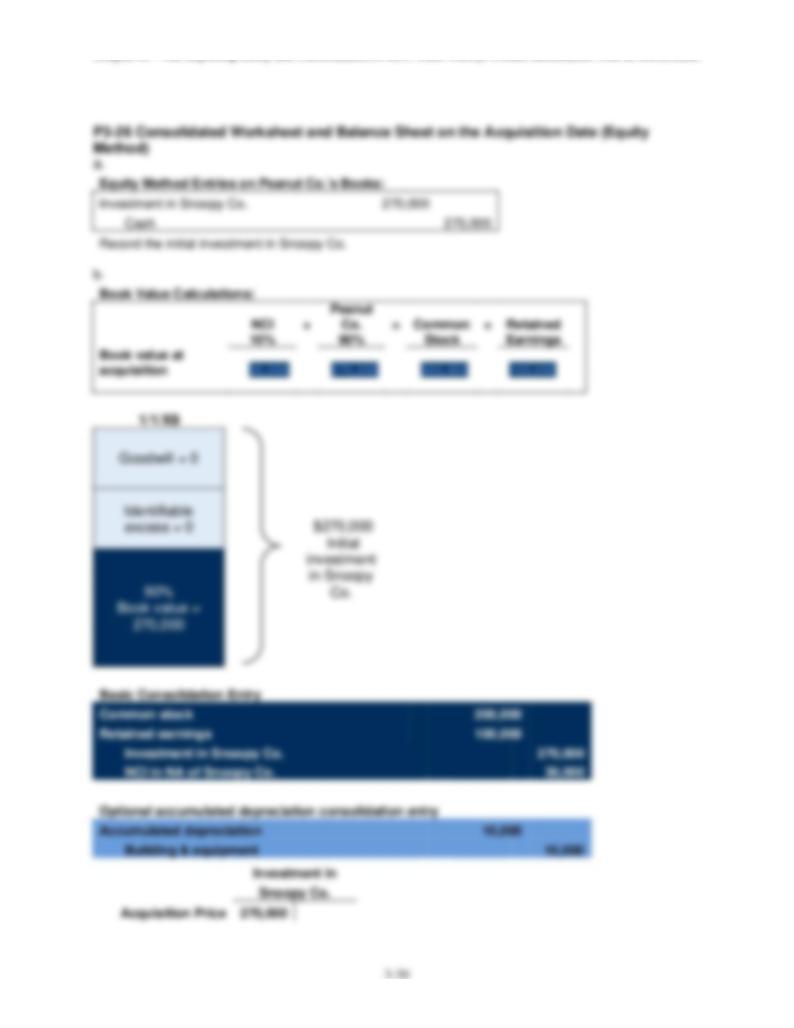
Chapter 03 - The Reporting Entity and Consolidation of Less-Than-Wholly-Owned Subsidiaries with no Differential

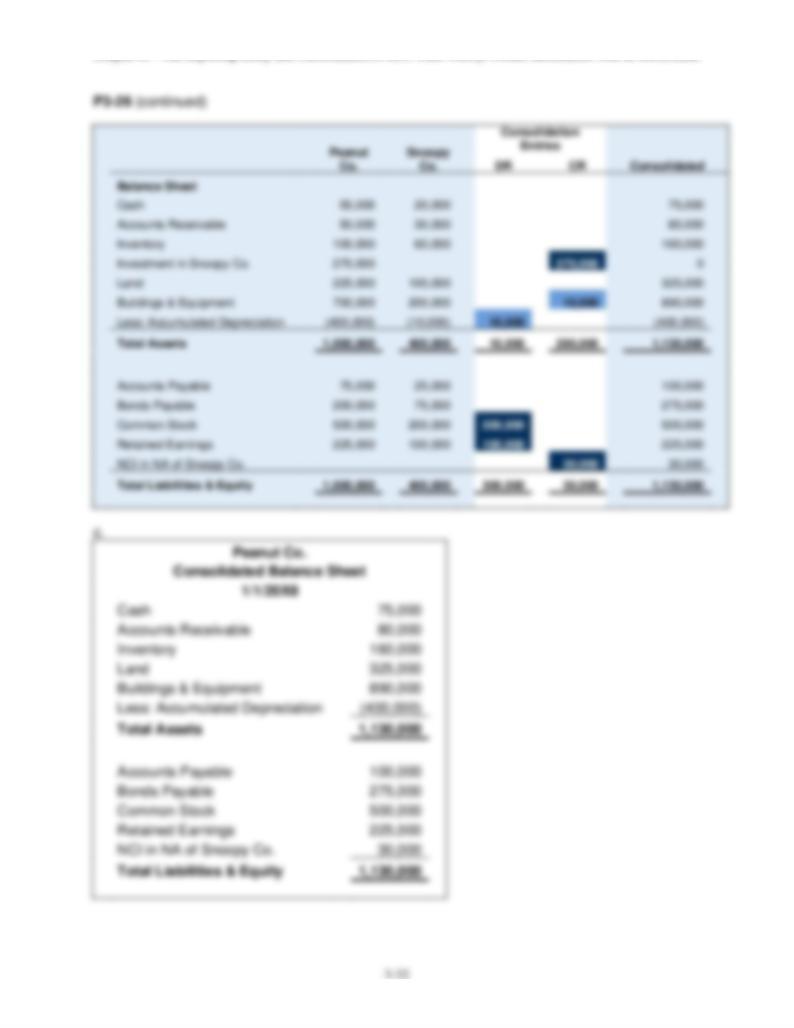
Chapter 03 - The Reporting Entity and Consolidation of Less-Than-Wholly-Owned Subsidiaries with no Differential
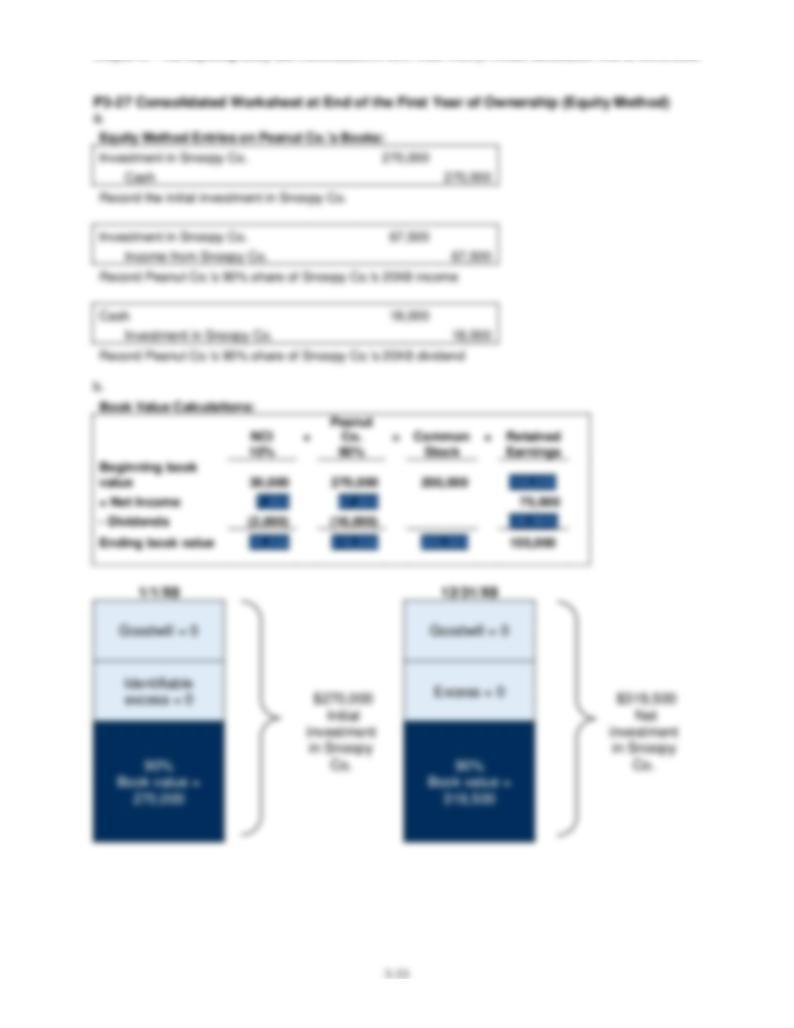
Chapter 03 - The Reporting Entity and Consolidation of Less-Than-Wholly-Owned Subsidiaries with no Differential
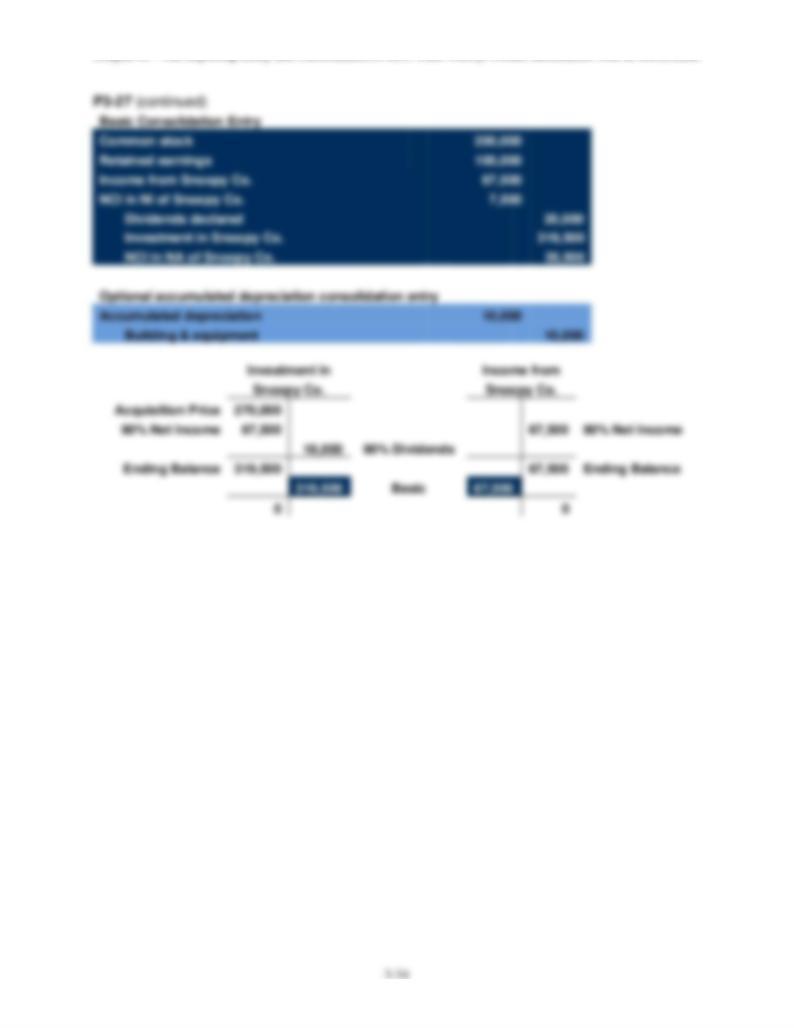
Chapter 03 - The Reporting Entity and Consolidation of Less-Than-Wholly-Owned Subsidiaries with no Differential
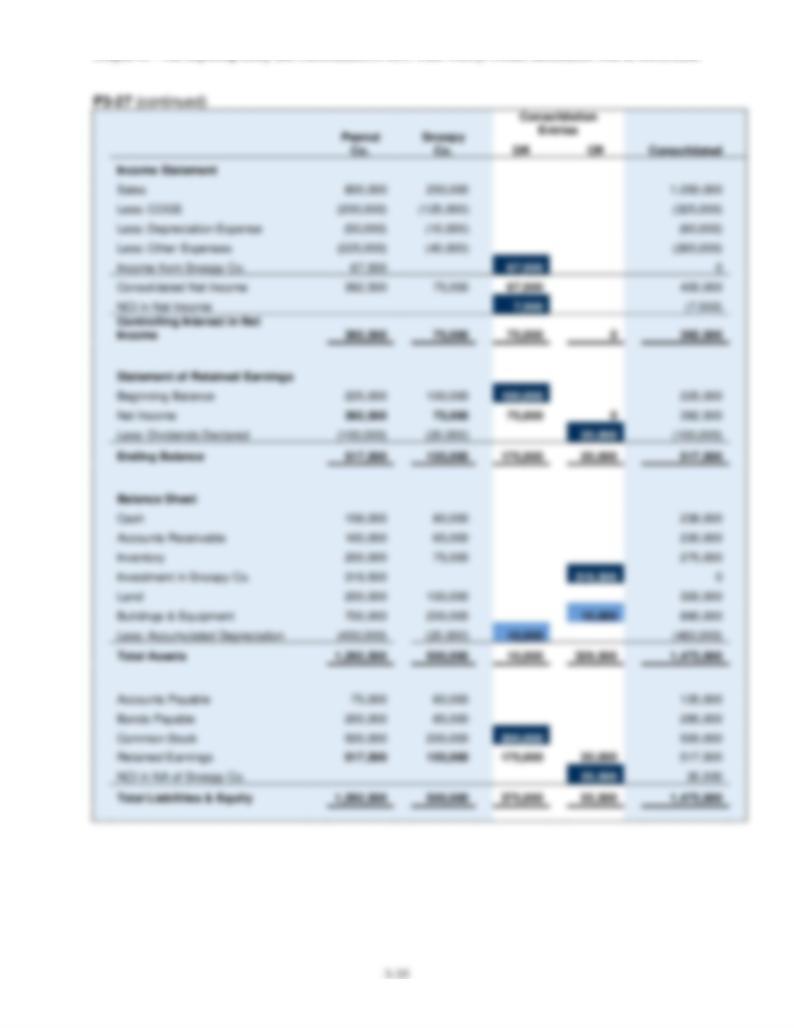
Chapter 03 - The Reporting Entity and Consolidation of Less-Than-Wholly-Owned Subsidiaries with no Differential
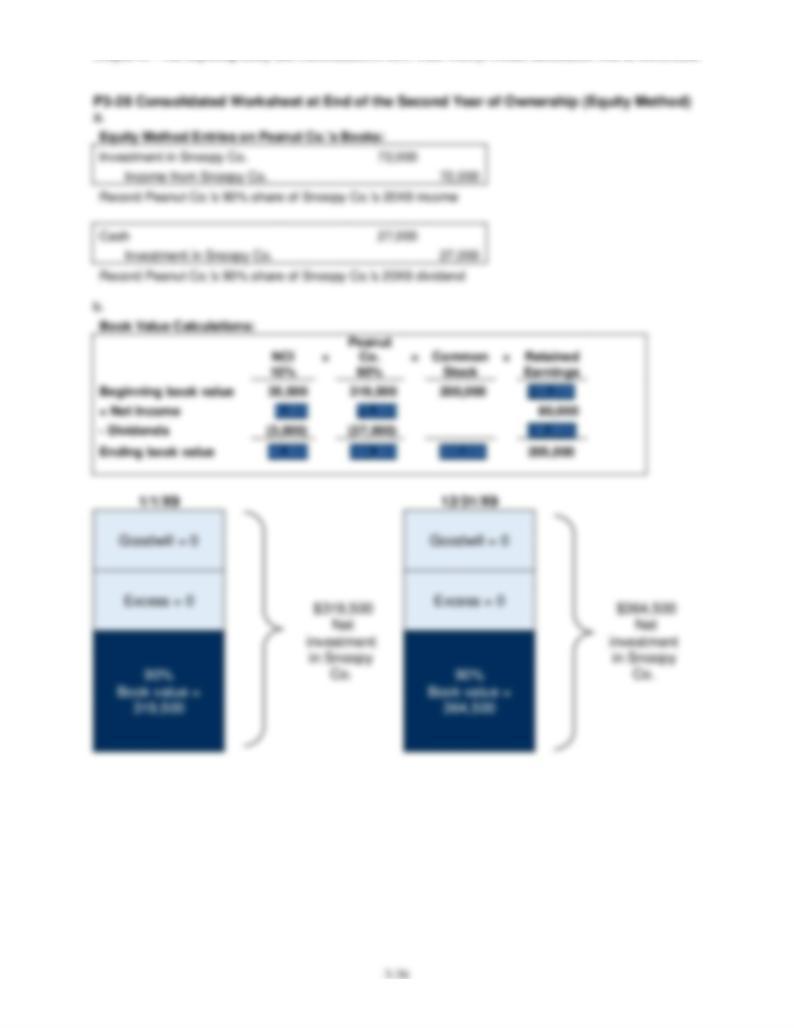
Chapter 03 - The Reporting Entity and Consolidation of Less-Than-Wholly-Owned Subsidiaries with no Differential
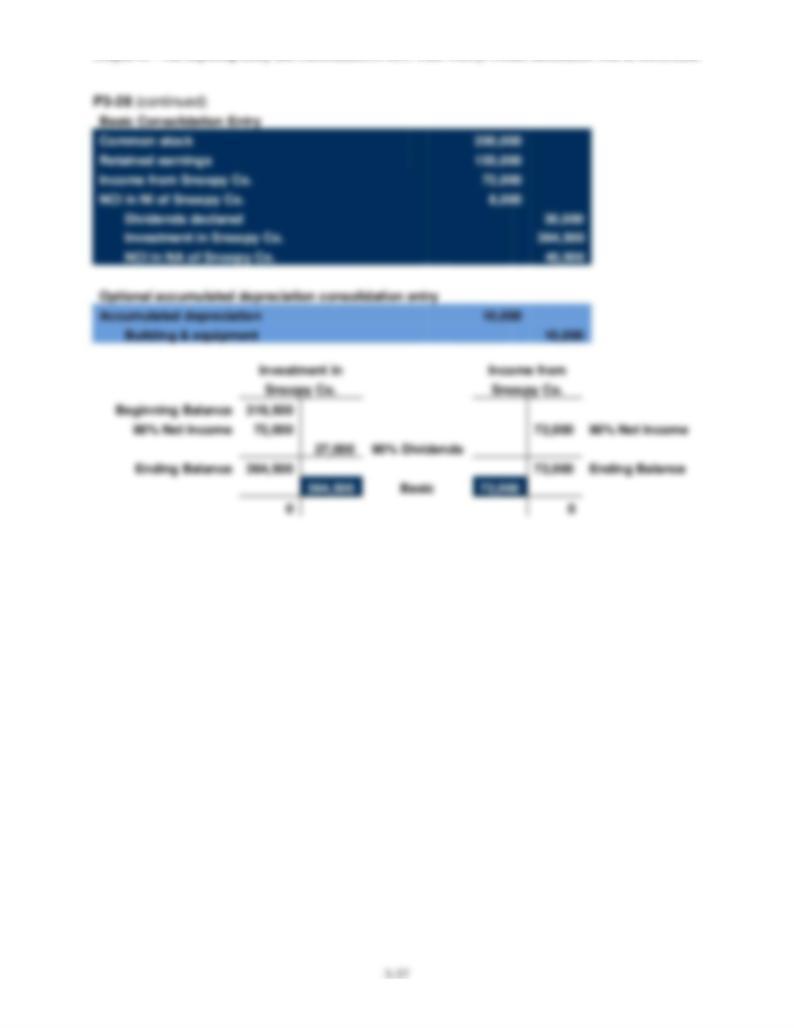
Chapter 03 - The Reporting Entity and Consolidation of Less-Than-Wholly-Owned Subsidiaries with no Differential
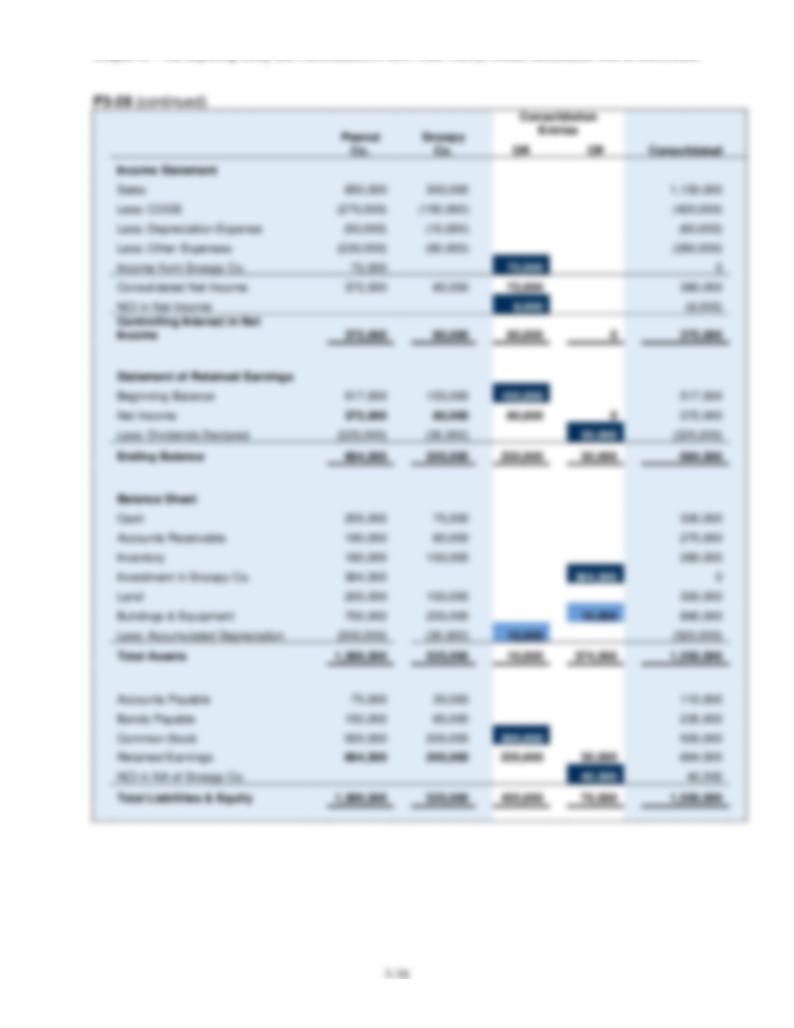
Chapter 03 - The Reporting Entity and Consolidation of Less-Than-Wholly-Owned Subsidiaries with no Differential
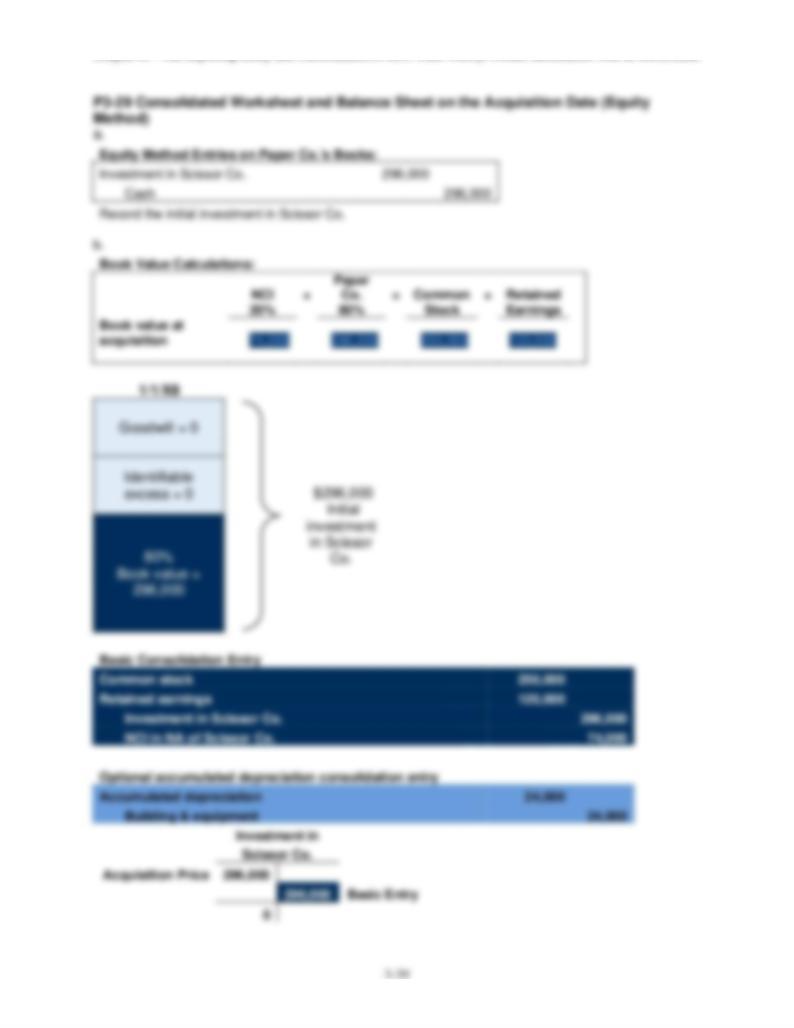
Chapter 03 - The Reporting Entity and Consolidation of Less-Than-Wholly-Owned Subsidiaries with no Differential
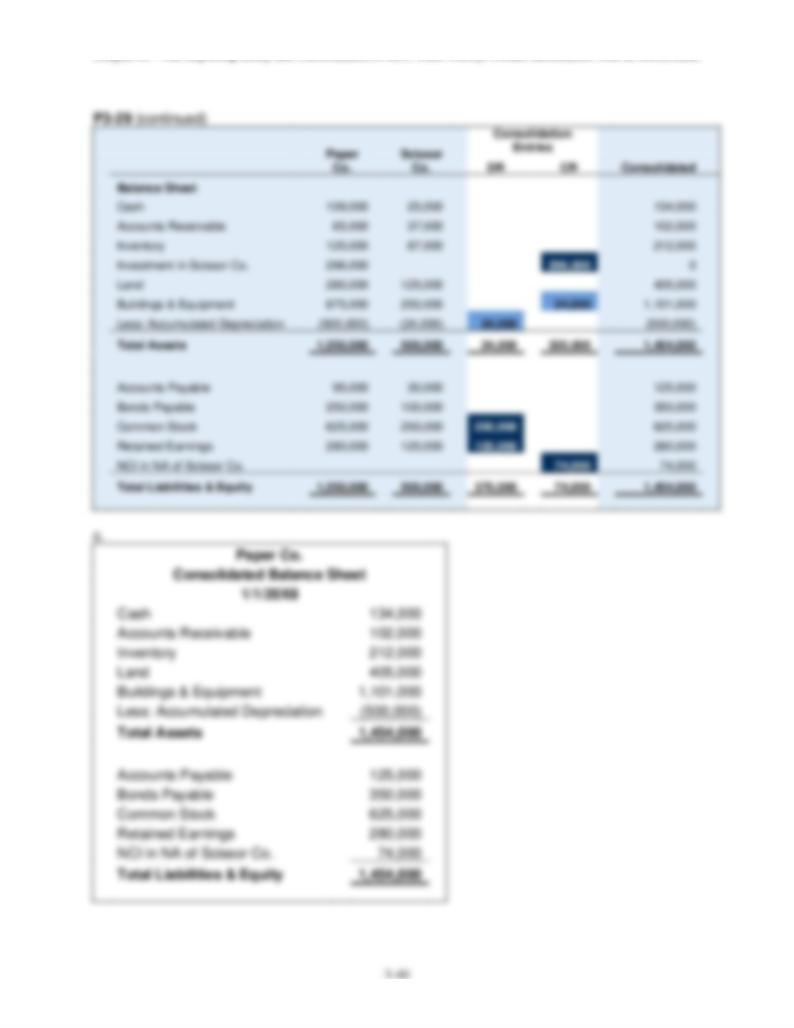
Chapter 03 - The Reporting Entity and Consolidation of Less-Than-Wholly-Owned Subsidiaries with no Differential
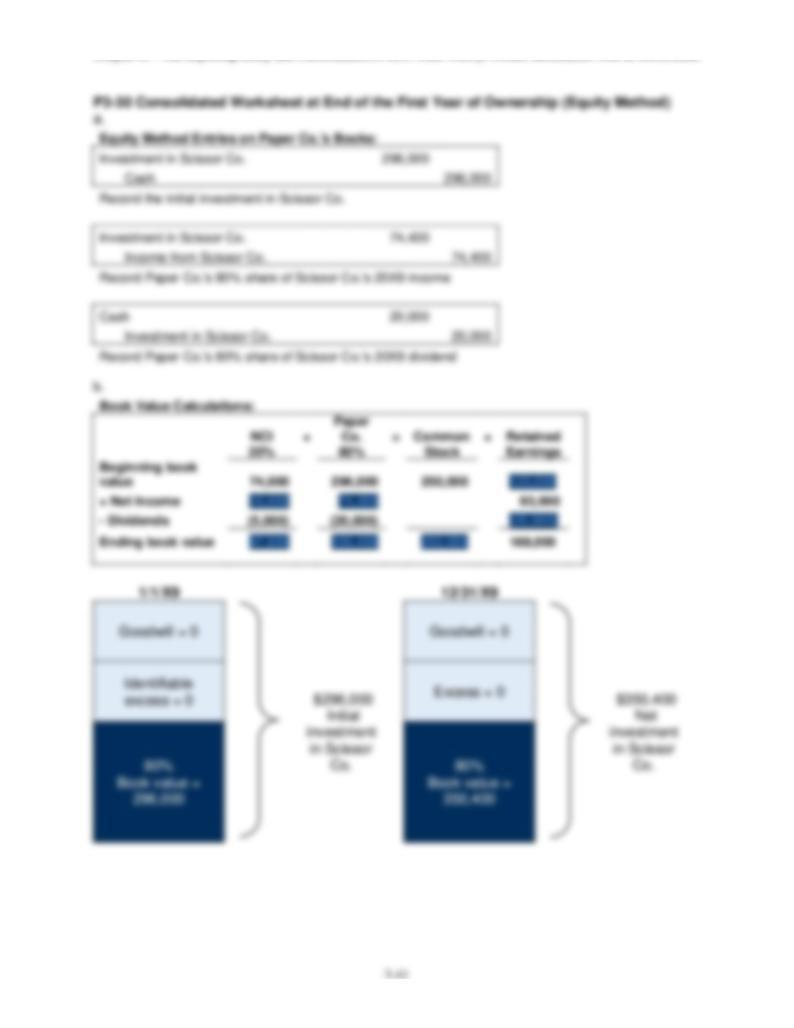
Chapter 03 - The Reporting Entity and Consolidation of Less-Than-Wholly-Owned Subsidiaries with no Differential
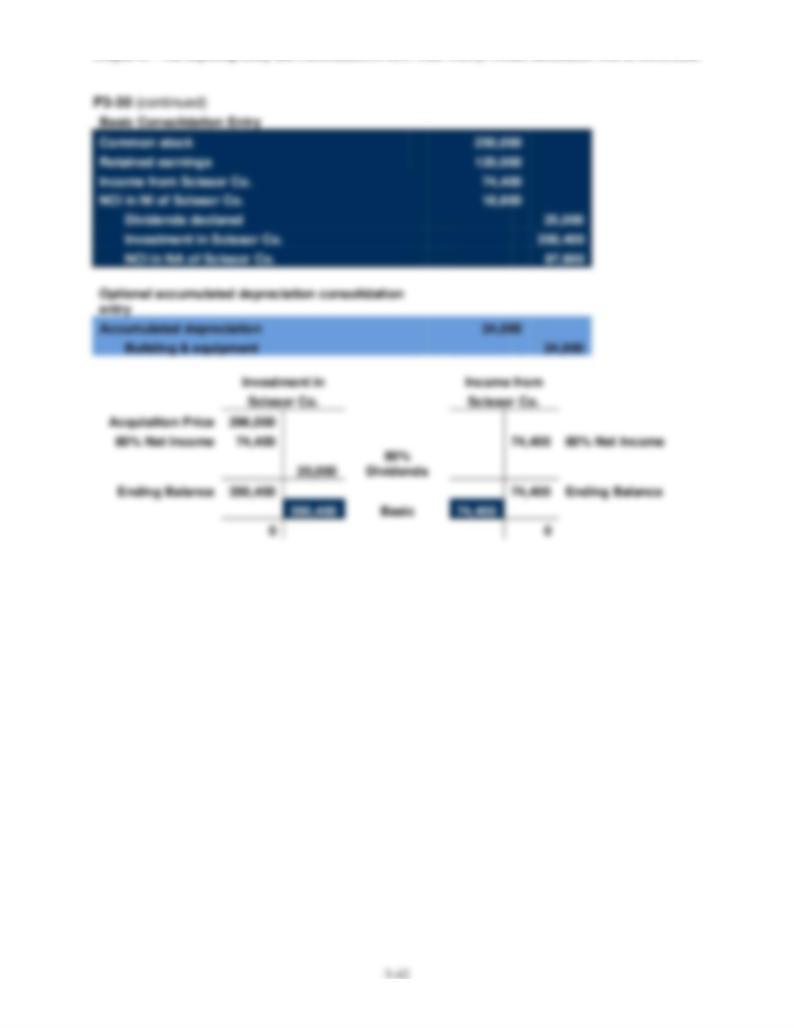
Chapter 03 - The Reporting Entity and Consolidation of Less-Than-Wholly-Owned Subsidiaries with no Differential
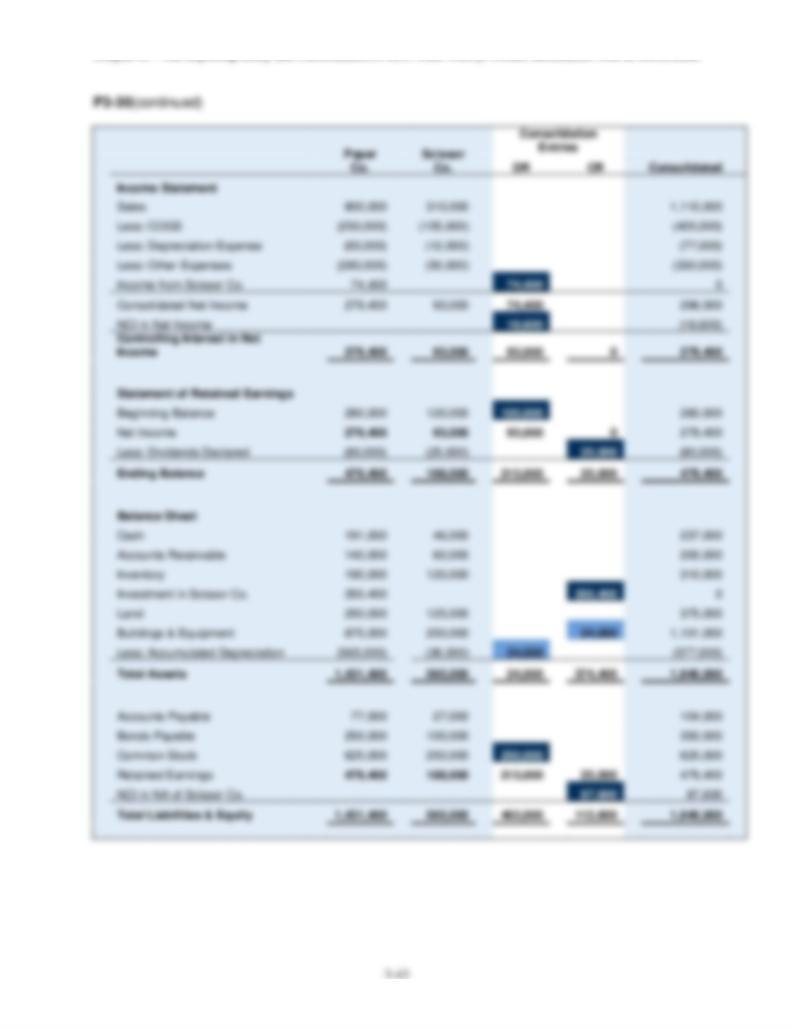
Chapter 03 - The Reporting Entity and Consolidation of Less-Than-Wholly-Owned Subsidiaries with no Differential
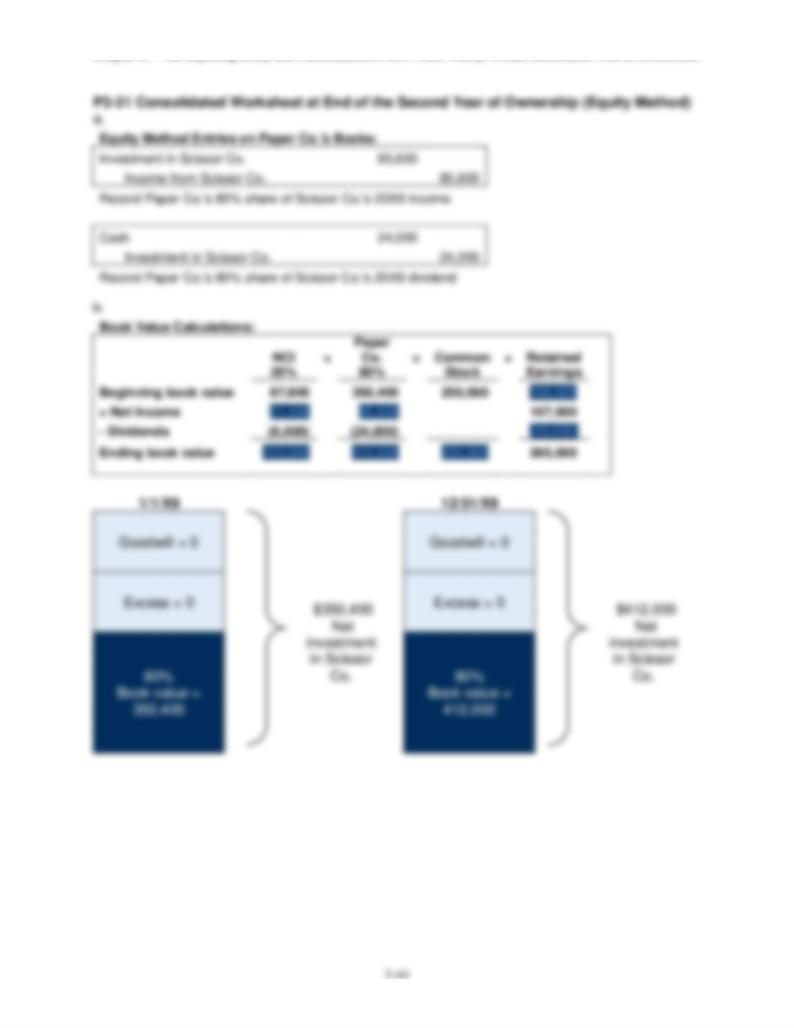
Chapter 03 - The Reporting Entity and Consolidation of Less-Than-Wholly-Owned Subsidiaries with no Differential
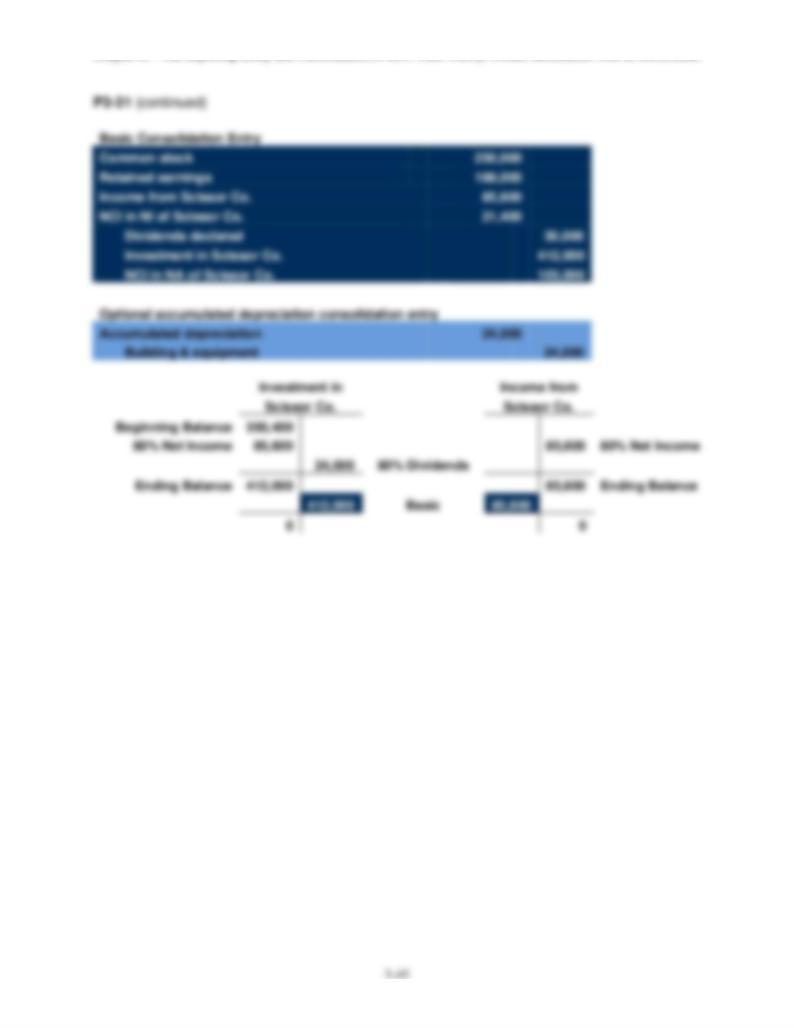
Chapter 03 - The Reporting Entity and Consolidation of Less-Than-Wholly-Owned Subsidiaries with no Differential
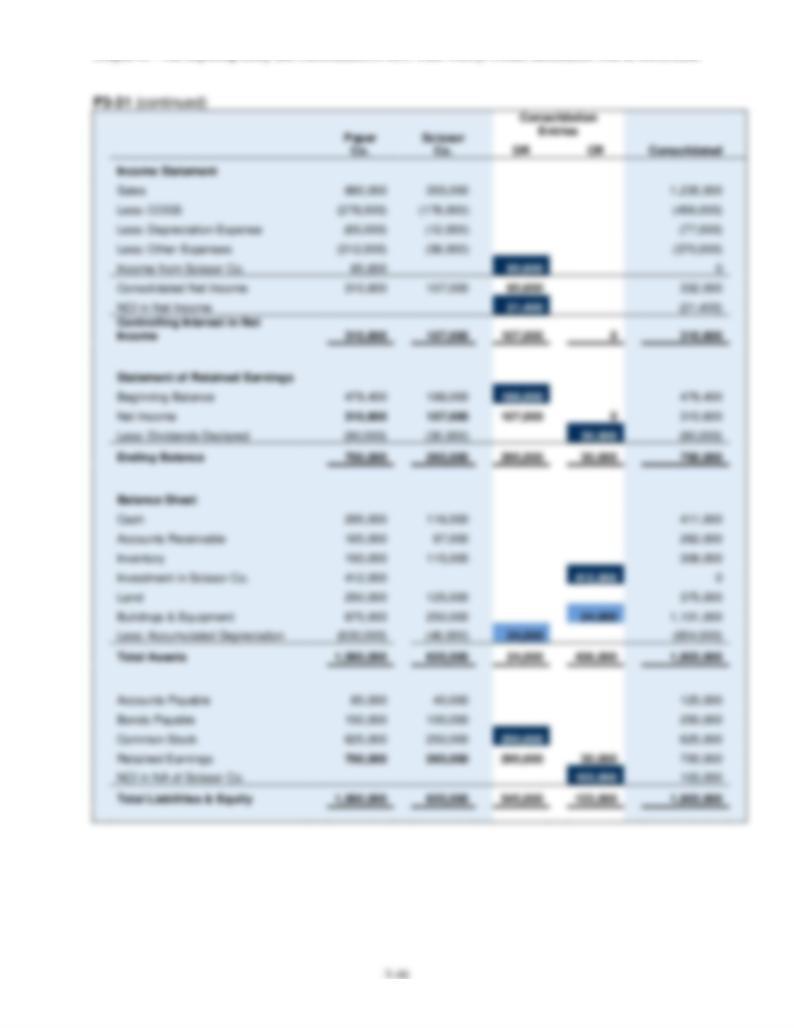
Chapter 03 - The Reporting Entity and Consolidation of Less-Than-Wholly-Owned Subsidiaries with no Differential